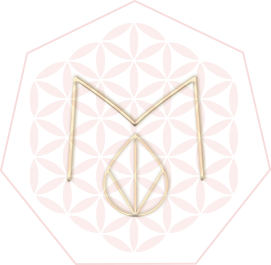by Marcela M. | Dec 11, 2012 | Blog, Christmas and NYE, cookies, Cooking basics and tutorials, Holidays, Recipe Box, Recipes, Sweets
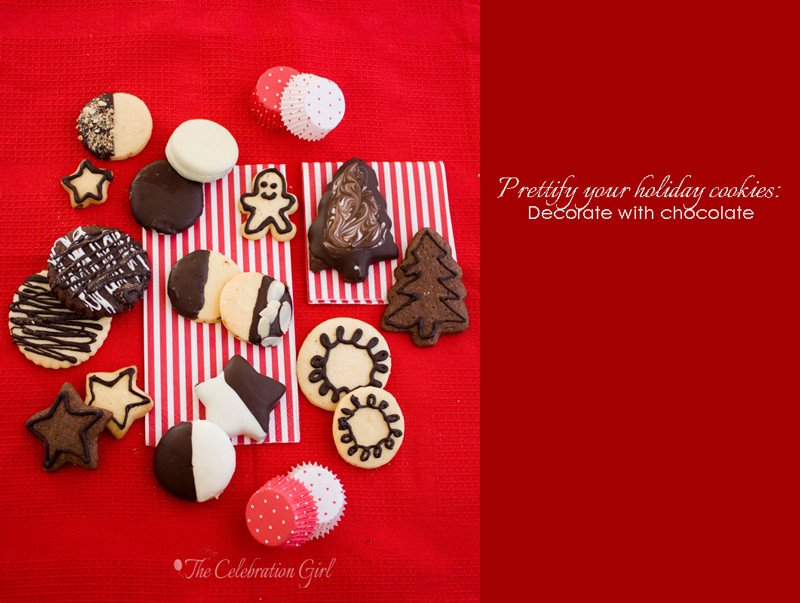
Good evening dear friends! Today, on day 11 of the advent, we continue decorating cookies, this time with a star ingredient: chocolate!
I love, love, loooove chocolate and I almost everyone I know also does, so I thought that it would be a good idea to include a mini section on super easy chocolate decorations. These are all very simple ways to spice up your cookies, that do not require anything more than a heat proof bowl for melting the chocolate, and a spoon. If you have a cooling rack to let the chocolate drip, so much the better, but if you don’t, you will still be able to make these cookies.
Working with chocolate can be tricky and the key is to melt it properly so as to achieve the right texture, and so as to make it last. It is important not to overheat it, or you will end up with something more similar to cookie dough than fluid, beautiful chocolate, and you should be particularly careful about this when working with white chocolate which, in my experience, can be quite moody.
Start by chopping the chocolate into small chunks and putting them in a heat proof bowl. Place the bowl over a saucepan containing a small amount of water, and bring it to low heat. The bowl should not touch the water, we just want the steam to melt the chocolate. Let the first pieces start to melt, shake the bowl a little bit and, when about 50% of it has melted, remove the bowl from the heat and mix with a wooden spoon. The remaining chocolate will melt when mixing. The reason I don’t let all chocolate melt over the heat is that it runs the risk of overheating (it has happened to me before). Once all chocolate is melted, continue mixing vigorously until it’s fluid and easy to work with.
Now that your chocolate is melted, let’s begin playing with those cookies!

You will need: dark chocolate, white chocolate and for some variations, ground nuts (I used almonds). You could also use chocolate/candy food coloring in case you want to add some more variety to the mix. Note that candy/chocolate coloring is different from general gel food coloring:it contains even less water, so as not to spoil the chocolate’s texture.Make sure that you are using the right kind!
Here are the versions I did:
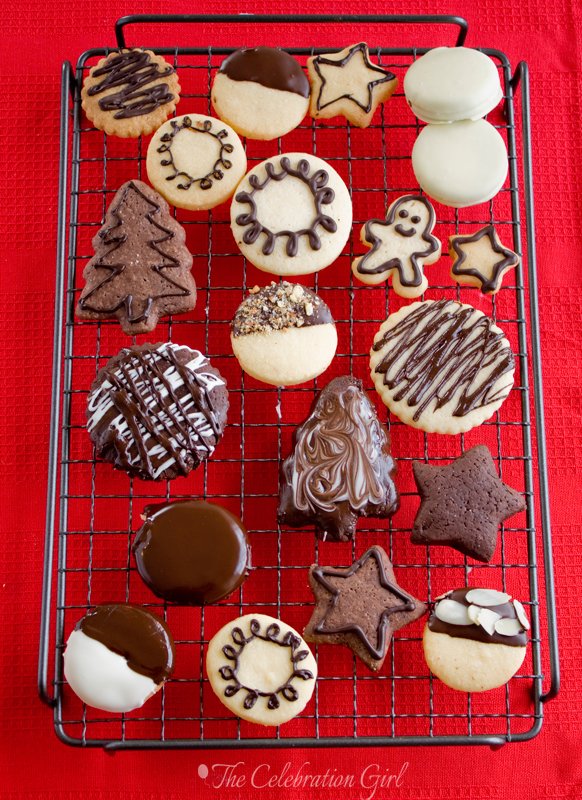
1) Full coverage: The first, most obvious option, is to fully cover the cookies in chocolate, either black or white. You can cover single or sandwich cookies, they both taste delicious. When you are covering your cookies fully, it is better to use a wire rack, because it allows the excess chocolate to drip, without creating a mess at the bottom. Simply pour a spoon or two of chocolate over the cookie, tap the rack against the counter a couple of times (so that the chocolate distributes evenly and there are no air bubbles) and let it drip and dry.

2) Half covered: This is an option that I like, not only because of how it looks, but also because the chocolate does not hide the cookie’s other flavors. It is very easy to do, as you can see from the pictures above: hold the cookie vertically, above the bowl of melted chocolate and, with a spoon or spatula, drop chocolate over the lower part of the cookie. Shake it slightly, so that the excess chocolate drips and then place it on a wire rack to finish drying.
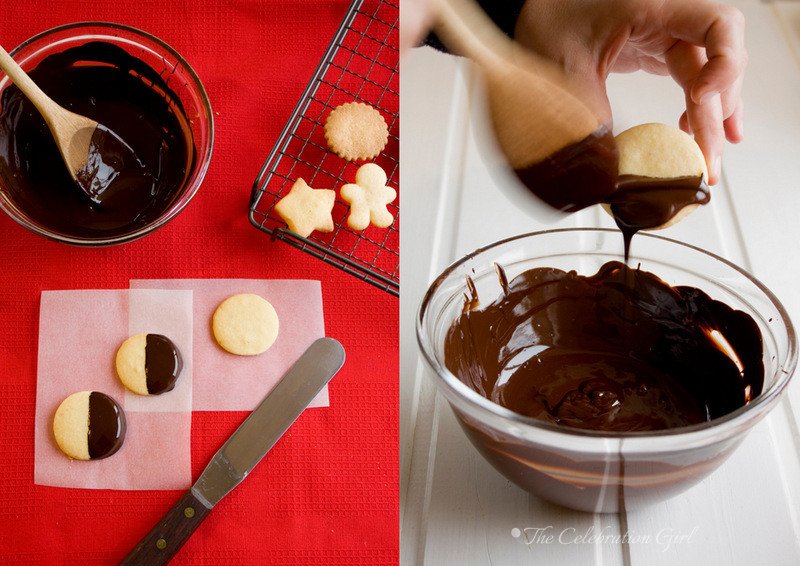
3) Half covered, with nuts: Pour crushed nuts of your choice, or slivered almonds over the chocolate, right after placing the cookies on the wire rack. Let it dry. This is a delicious option for shortbread cookies!

4) White and dark chocolate covered cookies: Another easy variation of the above, this time using both types of chocolate. Proceed to cover one side of the cookie, as shown in point 2 above, and let it dry. Once dry, cover the other half with the other chocolate. Let dry.
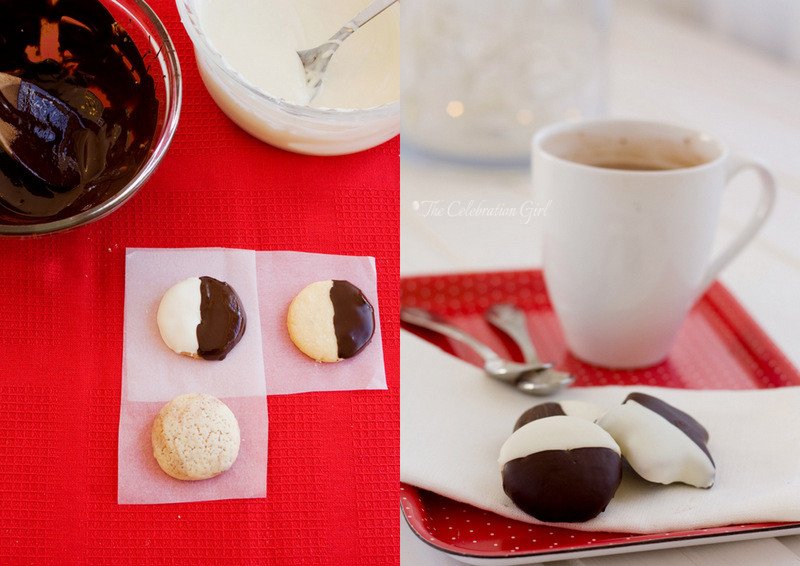
5) Marbled chocolate cookies: Cover the cookie completely with one color of chocolate and then, before it sets, add drops of the other chocolate here and there and immediately draw over them with a toothpick, moving your hand back and forth between the two chocolates.
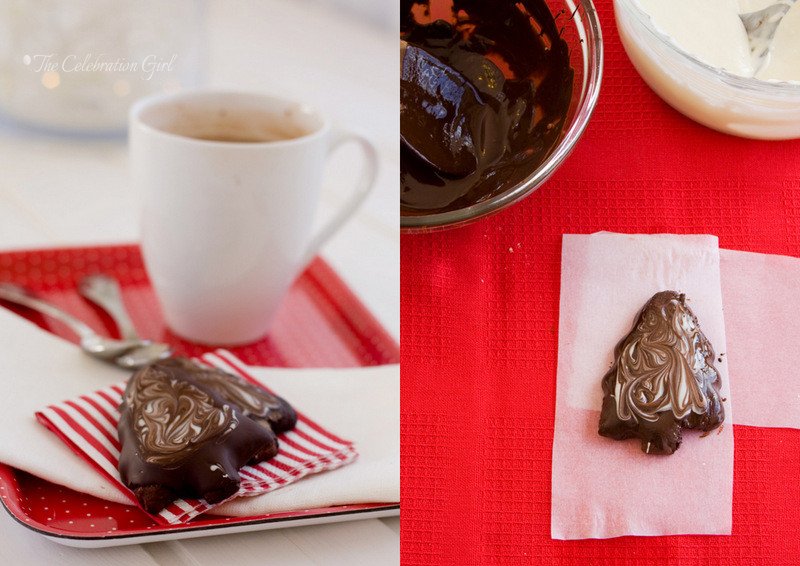
6) Piped chocolate cookies: In order to make this design, you will need a disposable piping bag or a paper cornet. If you want to know how to make a paper cornet to pipe chocolate, you can check THIS video from Dyane Bakes, which is great.
Melt the chocolate and, once it reaches the appropriate texture, introduce a few spoons inside a cornet or piping bag. Cut a small aperture at the bottom of it and draw as with a pencil brush. You will need to work fast because the chocolate may harden inside the piping bag quite fast. If this happens, put the piping bag under running warm water until it melts again.
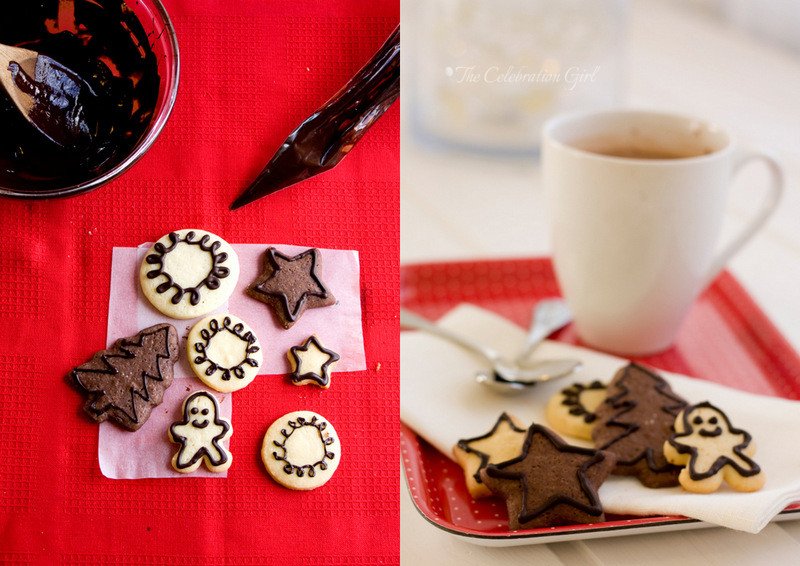
7) Chocolate stripes: Easy breezy. Hold the cookie over the bowl of melted chocolate, dip a spoon in it, let it drip until the stream of chocolate becomes thin and drizzle the cookie, moving your hand fast back and forth. Repeat with another color if you so desire.
Do you like these ideas? Which type of chocolate is your favorite?

Con sabor latino…
Buenas noches queridos amigos! Hoy, en el 11avo día del adviento vamos a seguir decorando galletitas, esta vez con un ingrediente estrella: el chocolate!
Amo, amo aaaaaaaaamo el chocolate, especialmente el bien amargo, y la mayoría de la gente que conozco tambien es fanática del mismo, así que pensé que podría ser una buena idea incluir una mini sección con decoraciones chocolatosas. Todas estas son formas muy sencillas de cambiar un poco sus galletitas, que requieren como todo instrumental un bowl resistente al calor para derretir el chocolate, y una cuchara. Si tienen una rejilla sobre la cual bañar las galletitas, es mejor porque ésta permita que el chocolate corra sin apelotonarse debajo, pero si no tienen una, tranquilos que tambien puede hacerse sólo quedará un poco menos prolijo).
Trabajar con chocolate tiene sus bemoles, pero la clave está en derretirlo correctamente y asegurarnos de templarlo bien antes de comenzar, para que tenga la textura adecuada y para que se deslice correctamente. Es muy importante no sobrecalentarlo, porque de hacerlo así terminaremos con un masacote más parecido a masa de galletas que a chocolate derretido! Tengan cuidado especialmente al trabajar con chocolate blanco, ya que en mi experiencia, es bastante temperamental.
Comiencen por cortar en trozos pequeños el chocolate y coloquenlos en un bowl resistente al calor. Luego, coloquen agua en una olla pequeña, y luego pongan el bowl sobre la misma, asegurándose que éste no toque el agua (sólo queremos que el vapor derrita el chocolate). Lleven la olla a fuego mínimo y,cuando el chocolate comience a derretirse,agitenla un poco para que el calor se distribuya. Cuando se haya derretido un 50% aproximadamente, retiren la olla del fuego y comiencen a mezclar vigorosamente. El chocolate restante se derretirá al entrar en contacto con el que ya está derretido, a medida que mezclamos. La razon por la que yo no dejo que todo el chocolate se derrita con la olla al fuego es que así se corre el riesgo de sobrecalentarlo, y arruinarlo (me ha pasado!). Una vez que todo el chocolate se ha derretido, continuen mezclando hasta que adquiera una textura fluida, con la cual sea facil trabajar.
Ahora que ya tienen listo su chocolate, empecemos a jugar con las galletitas!
Para hacer las galletitas que les mostraré a continuación necesitarán chocolate amargo o semi amargo y chocolate blanco y, para algunas, tambien nueces picadas a elección (yo usé almendras). Tambien pueden teñir el chocolate blanco con colorante, para añadir variedad, pero tengan en cuenta que los colorantes de chocolate no son los mismos que los de otras preparaciones, porque tienen que tener menor contenido de agua para no estropearlo. Asegurense de usar el colorante correcto si quieren teñir su chocolate!
He aquí las galletitas que hice en esta ocasión:
1) Galletitas totalmente bañadas en chocolate: Esta es la opción más obvia y sencilla.Pueden bañarse así galletas individuales o alfajorcitos, con cualquier chocolate. Ambas opciones son deliciosas. Cuando cubran sus galletitas completamente,tengan en cuenta que es mejor usar una rejilla para que el chocolate extra pueda gotear sin crear un pegotero en la base de la galletita. Para hacerlas, coloquen las galletitas sobre una rejilla, viertan una cucharada o dos de chocolate, golpeteen un par de veces la rejilla contra la mesada para que el chocolate se distribuya bien y no haya burbujas de aire, y dejen secar un par de horas.
2) Galletitas bañadas por la mitad: Esta opcion me encanta, no sólo por cómo luce sino tambien porque evitamos que el chocolate tape los aromas de las galletitas (sobre todo el negro, que puede ser invasivo). Hacerlas es muy sencillo: tomen la galletita y coloquenla de manera vertical sobre el bowl de chocolate. Con una cuchara o espatula, viertan chocolate sobre la mitad de la galletita, sacudanla un poco para que caiga el exceso y coloquenla sobre una rejilla para dejarla secar.
3) Galletitas bañadas por la mitad, con nueces: Espolvoreen nueces molidas a elección sobre la mitad cubierta de chocolate antes que se seque.Tambien pueden usar almendras fileteadas. Esta opcion es deliciosa con las galletitas de manteca.
4) Galletitas bicolor: Otra variante sencilla de la número 2. La clave está en hacer un lado primero, dejar que se seque, y luego bañar la otra mitad con el otro color.
5) Galletitas marmoladas: Bañen completamente la galletita con un chocolate y, una vez totalmente cubierta, agreguen gotas del otro chocolate en diversos lugares. Finalmente, dibujen diseños con un palillo escarbadiente, mezclando los chocolates, moviendo la mano en forma de 8.
6) Galletitas con contorno de chocolate: Para hacer este diseño necesitarán una manga descartable o hacer un cono de papel como el que indican en este video. Derritan el chocolate y, una vez que haya alcanzado el temple, coloquen un par de cucharadas dentro del cono o manga y dibujen como lo harian con un pincel. Tengan en cuenta que deberán trabajar rápidamente porque de lo contrario el chocolate se endurecerá dentro de la manga. Si les ocurre esto último, coloquen la manga bajo un chorro de agua caliente. Si usan un cono de papel deberan sacar los restos de chocolate seco del mismo y derretirlo nuevamente.
7) Galletitas con rayas de chocolate: Facilísimas. Tomen la galletita y sostenganla con una mano sobre el bowl con chocolate. Sumerjan una cuchara en el mismo, elevenla, dejando que el chocolate corra hasta que el hilo sea fino y una vez que así sea, dibujen rayas de chocolate, moviendo la mano de izquierda a derecha rápidamente. Repitan con el otro chocolate si asi lo desean.
¿Les gustan estas ideas? ¿Cuál es su sabor de chocolate preferido?
by Marcela M. | Dec 7, 2012 | Blog, Christmas and NYE, cookies, Holidays, Recipe Box, Recipes, Sweets
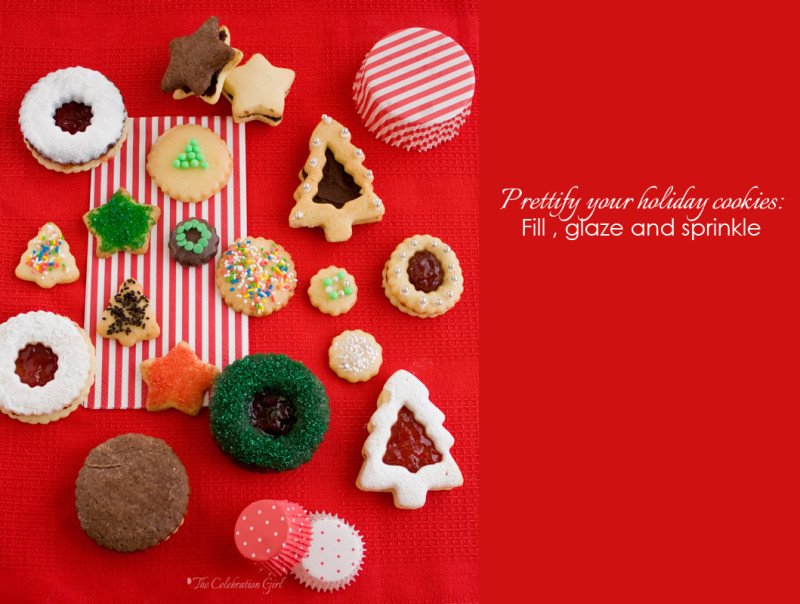
Good morning dear friends! 18 days until Christmas!
Now that you have made your cookie dough, baked them in different shapes and prepared your fillings and glazes, let’s play with them and add some more cookies to your assorted cookie box! You may also want to get sprinkles, non pareils, sanding sugar, blanched slivered almonds, crushed nuts, funfetti and any other decoration of your liking.
Ready? Ok, let’s begin. And remember: these are just a few ideas to spark your imagination. I am sure that, when you start playing with whatever you have in hand, you will find many more options!
1) Sandwich cookies: The easiest idea is to sandwich two cookies of the same size and shape with a filling of your choice. In my previous post, I gave you the recipe for a chocolate cream that tastes particularly delicious with the almond shortbread cookies, but you could also use nutella, vanilla cream, lemon curd, or jams and marmalades, such as orange, strawberry, or raspberry, for example.
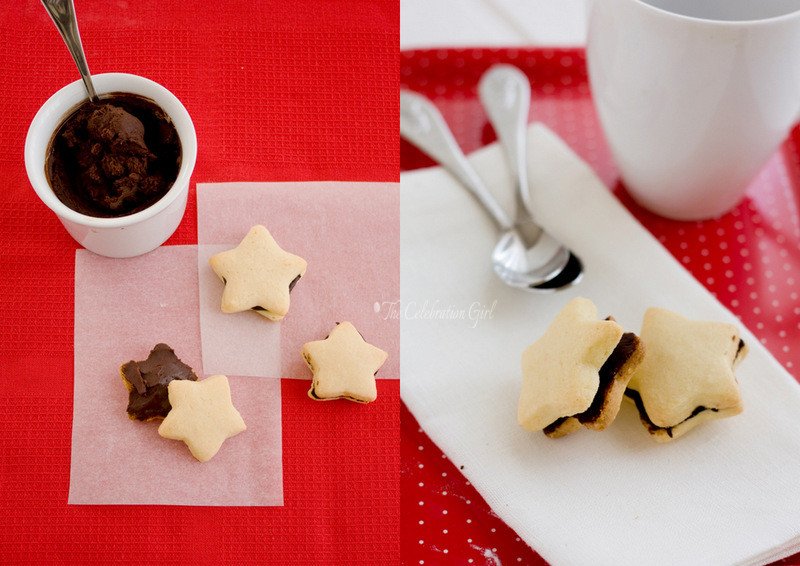
2) Combined sandwich cookies: This idea is a simple variation of the first one: combine the cookie flavors when sandwiching them. Different cookie recipes also have different textures and,when combined, they offer different taste experiences. You could combine, for example, a chocolate sugar cookie with an almond shortbread cookie, filling it with nutella; or join an orange sugar cookie with a vanilla sugar cookie, and sandwich them with lemon curd; or sandwich a lemon and an orange sugar cookie with raspberry or strawberry jam (the tart flavor of the citrus combines beautifully with the sweetness of the berries). Again, play around until you find your own favorites!

3) Linzer cookies: These look so pretty, don’t you think? They are two cookies, sandwiched with strawberry or raspberry jam, with the peculiarity that the top cookie has a cutout that reveals the jam, and has been sprinkled with confectioner’s sugar prior to sandwiching it (if you sprinkle the sugar after, it will cover the jam as well and the effect will be lost).
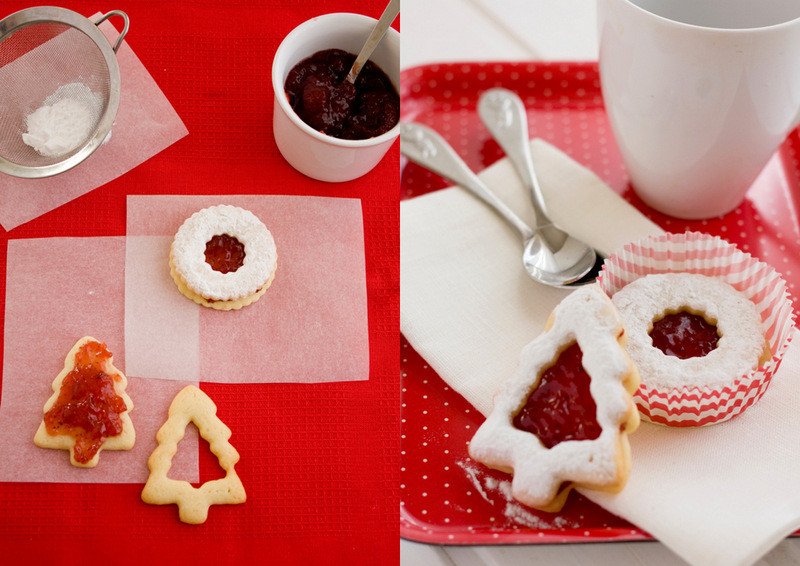
4) Linzer cookies, decorated with sugar pearls (instead of confectioner’s sugar): This is a sparkly twist on the traditional linzer cookies and, as you can see from the pictures, I changed the traditional filling as well, and used chocolate cream instead of jam in one of the cookies. In order to attach the sugar pearls you can use royal icing (home made or pre made as the one in the picture), or sugar glue.
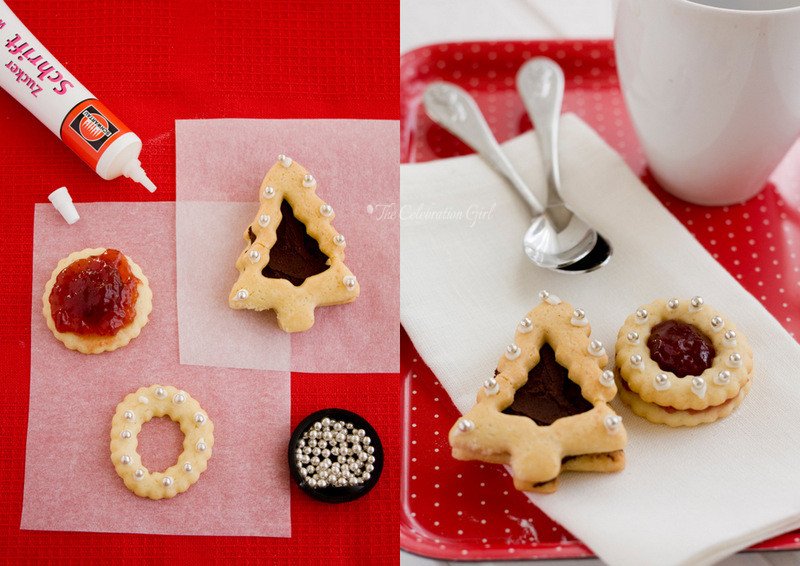
5) Lemon, orange or sugar glazed cookies: If you are thinking what to do with all the mini cookies you got left, after making linzer cookies, this is a good solution that also maximizes every bit of dough and saves you time. Place your cookies on a wire rack, pour one tablespoon of the glaze of your choice over each of them (Lemon glaze is my favourite) and let it set. You could also move your spoon back and forth, quickly, when pouring the glaze, to create stripes of glaze instead of giving the cookies of full coverage.
6) Glazed cookies, decorated with sprinkles: This is a variation of the ones above. Place your cookies on a wire rack, pour one tablespoon of the glaze of your choice over each of them and immediately spread a few sprinkles over them. I used the ones I have, but red and green ones would look adorable and appropriate for this season. Let the glaze set.
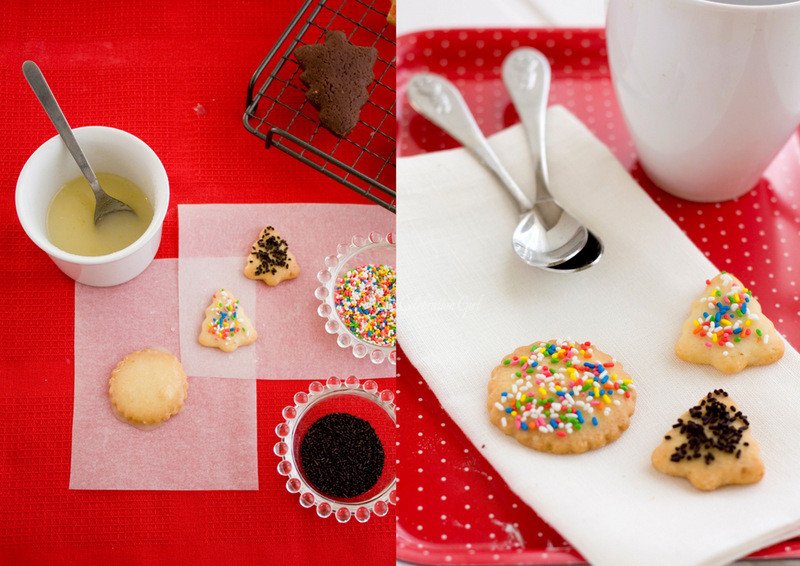
7) Glazed cookies, decorated with sanding sugar: Another easy variation to use with glaze.Just as before, place your cookies on a wire rack, pour one tablespoon of the glaze of your choice over each of them and immediately spread sanding sugar over them. Let the glaze set and then lift the cookies and shake them to remove the excess sugar.
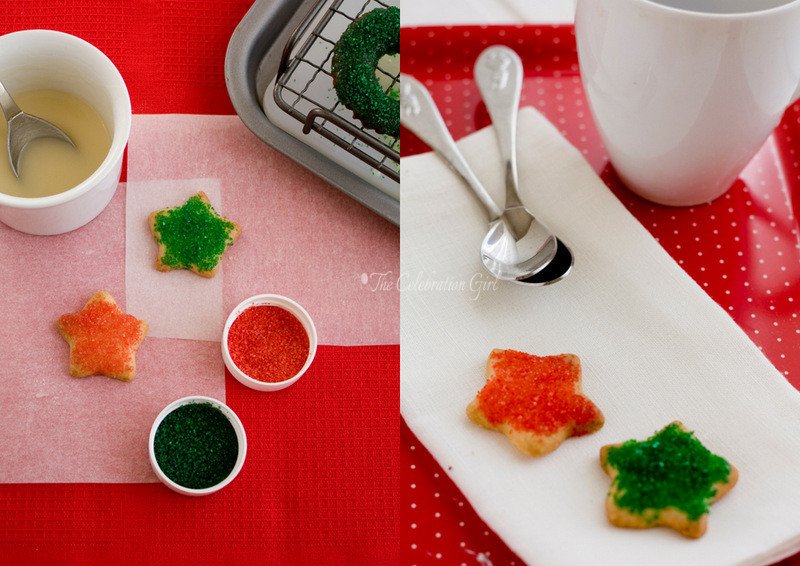
8) Linzer cookies, glazed and decorated with sanding sugar: This option would look particularly pretty with a Christmas tree shaped linzer cookie, but I thought about it too late (he). In order to make it, fill the bottom cookie with jam or other filling, as it is traditional but, instead of sprinkling the top cookie with confectioner’s sugar, put it on a wire rack, glaze it and add sanding sugar to it (as in the cookies above). The result will be a sparkly, crunchy linzer cookie that the kids will love!

9) Lemon glazed sugar cookies, with Christmas designs made with sprinkles and funfetti: Finally, here is a way to let out the little artist in you and/or play with the kids. Take all your sugar decorations out , pour the glaze of your choice over the cookies, and have fun creating Christmas shapes. I made a tree and a couple of wreaths but you could also make elf hats, stockings, stars…anything!
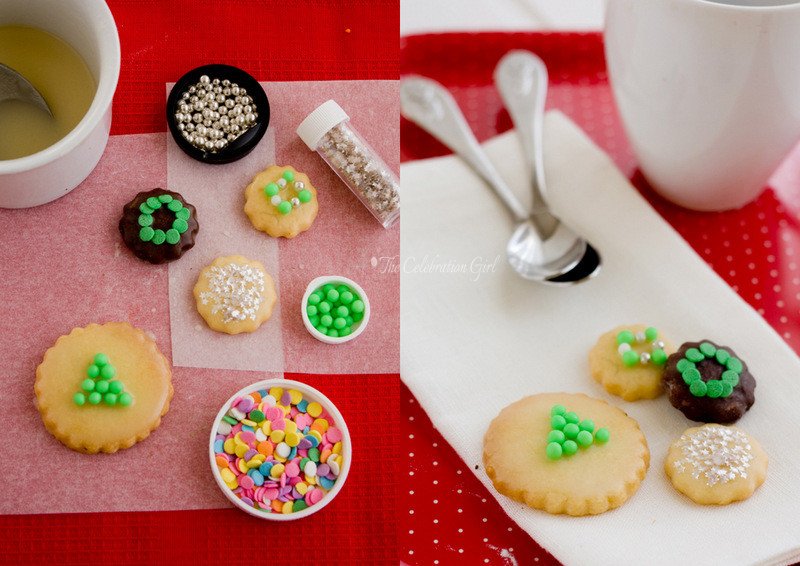
Have fun decorating cookies! And make some extra dough, because there are more ideas to come!
Con sabor latino…
Buenos días queridos amigos! Faltan sólo 18 días para la navidad!
Ahora que ya han preparado la masa de sus galletitas, las han horneado con formas diferentes, y tienen los rellenos y glaseados listos, es hora de comenzar a jugar con todos estos elementos y ampliar la variedad de nuestras cajas de galletitas surtidas. Preparen todos los ingredientes, y busquen todas las granas, azucares, perlas, non pareils, nueces, funfetti y demas decoraciones que anden dando vuelta por sus casas, porque vamos a darles buen uso!
Listos? Comenzamos! Las ideas que les voy a mostrar a continuación son sólo algunas de las tantas posibilidades que existen…cuando empiecen a jugar con sus materiales y dejen volar su imaginación seguramente crearán muchas otras combinaciones diferentes!
Estas son mis opciones:
1) Galletas rellenas: La idea más sencilla de todas, sin, dudas, es la de unir dos galletitas de la misma forma y tamaño con un relleno que nos guste. La idea me gusta más con galletitas en miniatura, quedan más delicadas, pero eso es cuestión de gustos. En mi post anterior compartí la receta de una crema de chocolate que es ideal para combinar con las galletitas de almendra, pero tambien pueden usar otros rellenos, como nutella, crema de vainilla, lemon curd, o bien mermeladas y jaleas de naranja, frutilla o frambuesa, entre otras.
2) Galletas rellenas combinadas: Una variante simple de la opción anterior es combinar los sabores de las galletitas que uniremos con relleno. Por otra parte, diferentes recetas otorgan galletitas con textura diferente y, cuando las combinamos, ofrecen una experiencia gustativa diferente. Algunas combinaciones que me gustan mucho son, entre otras: galletita de chocolate y de almendras con relleno de nutella, galletita de naranja y vainilla con relleno de lemon curd, o galletita de limon y galletita de naranja con relleno de frambuesas o frutillas (la acidez de los citricos combina deliciosamente con la dulzura de las fresas y frutos del bosque). Jueguen hasta encontrar sus favoritas!
3) Galletitas Linzer: Son tan bonitas, no les parece? Se trata de dos galletitas, unidas con mermelada de frambuesa o frutilla, que tienen la peculiaridad de que la galletita superior está ahuecada, dejando ver el relleno, y ha sido espolvoreada con azucar impalpable antes de unir. Es necesario espolvorearla con azucar antes de unirla porque, si lo hacemos despues, el azucar cubrirá la mermelada y se perderá el efecto tradicional.
4) Galletitas Linzer, decoradas con perlas de azucar en lugar de azucar impalpable: Una variación para darle un poco de brillo a las Linzer tradicionales. Noten tambien que, en esta ocasión, tambien jugué con los rellenos y me tomé la libertad de colocar crema de chocolate en una de las galletitas. Las perlas de azucar pueden pegarse a la galletita con glacé real (casero o envasado), o bien con pegamento de azucar (sugar glue).
5) Glaseado de limón, naranja o azúcar: Esta es una buena solución para todas aquellas mini galletitas que les quedaron despues de ahuecar las que usaron para hacer las linzer, y asi ampliar de manera eficiente la variedad de su cajita de galletas surtidas. Coloquen la galletita en una rejilla y viertansobre la misma el glaseado que más les guste ( el de limon es mi preferido) y dejenlo secar. Tambien pueden glasearlas moviendo la cuchara hacia delante y hacia atrás, rápidamente, para crear un efecto zebra.
6) Galletitas glaseadas y decoradas con granas de colores: Una variación de la opción anterior. Coloquen la galletita en una rejilla, viertan sobre la misma el glaseado que más les guste e, inmediatamente despues, espolvoreen granas de colores. Yo usé las que tenía en casa, pero una combinación de granas verdes y rojas se vería preciosa y apropiada para esta época. Dejen secar el glaseado
7) Galletitas glaseadas y decoradas con azucar de colores: Coloquen la galletita en una rejilla y viertan sobre la misma el glaseado que más les guste e, inmediatamente, espolvoreen azucar de colores encima. Dejen secar el glaseaso y luego levanten la galletita con cuidado, y agitenla un poquito, para dejar caer el azúcar extra.
8)Galletitas linzer, glaseadas y decoradas con azucar de colores: Esta opción es ideal para las galletitas linzer con forma de arbolito de navidad pero se me ocurrió demasiado tarde (je). Para hacerla, rellenen la galletita de abajo de la manera tradicional pero, en lugar de espolvorear la galletita superior con azucar impalplable, colóquenla en una rejilla, viertan el glaseado deseado y luego espolvoreen azucar de colores sobre el mismo. El resultado será una galletita linzer brillante y crujiente que los niños adorarán!
9) Galletitas con glaseado de limón, y diseños hechos con granas y perlas de azucar. Finalmente, les dejo una opción para sacar su artista interior y/o jugar con los niños. Tomen todas sus decoraciones de azucar, coloquen la galletita ahuecada en una rejilla y viertan sobre la misma el glaseado que más les guste y luego diviertanse dibujando formitas navideñas con granas, perlas, funfetti y demás. Yo hice un arbolito y varias coronas, a modo de ejemplo, pero tambien pueden hacerse bastoncitos, gorros de elfo, medias navideñas, estrellas…prácticamente cualquier cosa!
Espero que se diviertan muchísimo decorando sus galletitas! Y guarden masa o hagan de más, porque la semana que viene llegarán más ideas todavía!
by Marcela M. | Dec 6, 2012 | Blog, Christmas and NYE, cookies, Cooking basics and tutorials, Holidays, Recipe Box, Recipes, Sweets
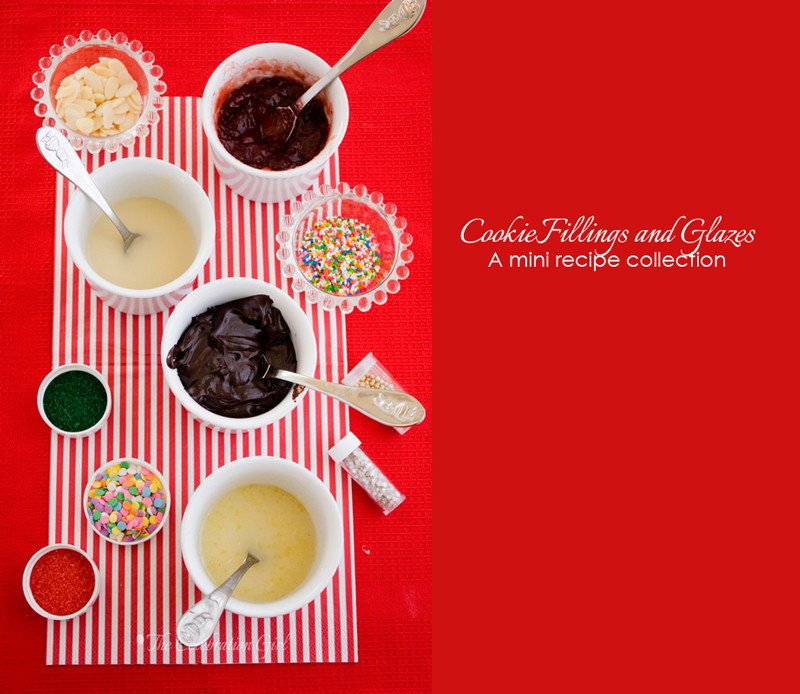
Good morning dear friends! Day 6 of the advent, almost 1 week into the season already and the weekend is almost here!
Today’s post is, in fact, the first part of a longer post that will be completed tomorrow, when we continue playing with the cookies we made before . These are some of the recipes I will be using and, for brevity sake and not to make one post super long, I thought it better to divide it in two. So, here are some of my favorite glazes and fillings to go with the cookie doughs I shared with you on Day 3.
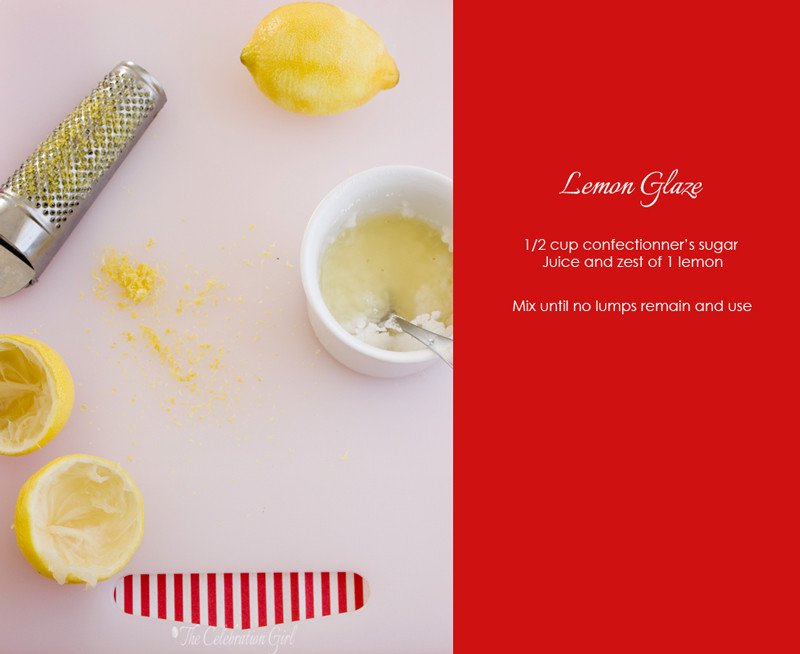
I also like to glaze my cookies with an orange glaze. In order to make it, use juice and zest of an orange instead of that of a lemon, in the same quantities and in the recipe above.
When I want to make a more traditional unflavored sugar Sugar glaze, I mix 1/2 cup confectioner’s sugar, 1 tablespoon warm water, 1 teaspoon of golden syrup and 1 teaspoon vegetable oil until no lumps remain. Traditionally this glaze uses melted butter but, as I have mentioned before, I prefer to skip using dairy as much as possible due to my son’s mild intolerance.
This a great filling, especially for almond or hazelnut shortbread cookies. There is something about pairing nuts and chocolate that is just heavenly perfect. I use coconut cream when I want to make a dairy free version, keeping the quantities stable.
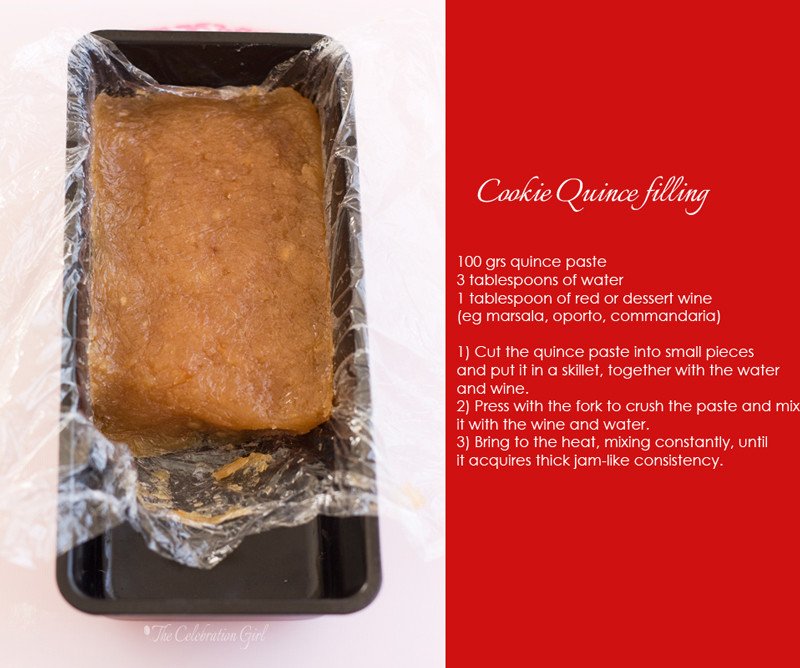
Quince paste or “Dulce de Membrillo”, as we call it back home, is a staple food in most Argentinian homes (or at least it was in mine when I was growing up), but outside of Argentina it isn’t that easy to find. A friend of my mother’s recently shared with me this wonderful recipe and I put it in use, taking advantage of quince season, with the idea of making the famous pastafrola. However, when I thought about fillings for the advent’s cookies, I realized that quince paste would make a wonderful one. I gave it the necessary jam-like consistency using the same method I use for making pastafrola’s filling (quantities vary, though). Here you have it:

So, get those fillings and glazes ready, because we will be using them tomorrow!
What are your favourite sugar cookie fillings and glazes?
Con sabor latino…
Buenos días queridos amigos! Es el 6to día del adviento, ya ha transcurrido casi una semana de la temporada festiva y el fin de semana nos pisa los talones.
El post de hoy es, en realidad, la primera parte de un post más largo que completaré mañana, cuando continuaremos jugando con las galletitas que horneamos anteriormente. Estas recetas son algunas de las que usaré mañana, así que para no hacer un solo post larguísimo, decidí dividirlo en dos. Aquí tienen, entonces, algunos de mis rellenos y baños favoritos para las galletas que compartí con ustedes el 3er día del adviento:
1) Glaseado de limón: Mezclar 1/2 taza de azucar impalpable con el jugo y la ralladura de 1 limón, revolviendo bien hasta que no queden grumos.
2) Glaseado de naranja: Mezclar 1/2 taza de azucar impalplable con el jugo y la ralladura de una naranja. Revolver bien hasta que no queden grumos.
3) Glaseado de azucar: Mezclar 1/2 taza de azucar impalplable con 1 cucharada de agua caliente, 1 cucharadita de golden syrup (azucar invertido) o syrup de maiz y una cucharadita de aceite vegetal, revolviendo hasta que no quede ningun grumo. Tradicionalmente, esta receta lleva manteca pero yo uso aceite a causa de la leve intolerancia a los lacteos de mi hijo.
4) Relleno de crema de chocolate: Colocar 60 grs de chocolate amargo en un bowl. Llevar 1/3 de taza de crema de leche al fuego, retirar cuando rompa el hervor y verter sobre el chocolate, dejando que éste se disuelva. Una vez casi completamente disuelto, batir vigorosamente hasta obtener una crema. Agregar 2/3 tazas de azucar impalpable y mezclar bien, hasta que no queden grumos. Si quieren hacerla sin lacteos, reemplacen la crema de leche por crema de coco.
5) Dulce de membrillo casero: Lavar y cepillar 2 membrillos y colocarlos en una olla con agua hirviendo durante 10 minutos. Retirar, dejar enfriar, pelar y procesar. Pesar la pasta resultante, que tiene que dar aproximadamente 500 grs. Agregar 400 gramos de azucar granulada comun (si es menos o mas, ajustar la cantidad proporcionalmente), cubrir con papel film y dejar reposar toda la noche. Al día siguiente, colocar en una olla de hierro, tipo Le creuset o essen, y llevar a fuego revolviendo constantemente con cuchara de madera hasta que la pasta se desprenda del fondo y de los bordes. Cubrir un molde de budin con papel film, verter dentro la pasta de membrillo, apretando con una cuchara para que quede compacta. Cubrir la pasta con papel film, bien al ras y asegurandose que no queden burbujas de aire. Dejar reposar en la heladera.
6) Pasta jalea de membrillo (para rellenar galletitas): Cortar 100 grs de membrillo en trozos y colocar en una sarten, junto con 3 cucharadas de agua y 1 cucharada de vino tinto o de postre. Pisar con tenedor para ablandar la pasta e integrarla con los líquidos. LLevar a fuego, pisando y revolviendo constantemente, hasta que adopte una consistencia de mermelada bien espesa.
Ya lo saben: vayan preparando estos rellenos y glaseados, que mañana comenzaremos a usarlos!
Y de paso, cuentenme, cuales son sus preferidos?
by Marcela M. | Dec 4, 2012 | Blog, Christmas and NYE, cookies, Holidays, Recipe Box, Recipes, Sweets

Good morning friends! It’s day 4 of the advent, and it’s only 20 days until Christmas eve, can you believe it? I know it’s a real cliché, but I have no idea where time went this year. Let’s make the most of this last month, shall we?
I hope you have your cookie doughs ready because we are going to put them to good use today. So, take them out of the freezer or refrigerator and gather your cookie cutters, a few sugar pearls and nonpareils because we will start making pretty cookies for your assorted cookie box.
We will start by the simpler cookies and, in following posts, I will show you other techniques and ideas and we will increase difficulty as we go. As I have mentioned before, I want to encourage you to bake with your children and, for this reason, I decided to include easy cookies that you can make even with toddlers. When baking with small children, though, I would recommend you to bear in mind two things: 1) Forget about the mess and about the end result. You can always bake perfect cookies later. Baking with children is more about having fun and letting them be creative in the kitchen, letting them familiarize themselves with the tools of the craft and about sharing special moments, building memories. 2) Make extra dough, because they will soon discover that unbaked cookie dough tastes delicious!
I used a few of the cookie cutters I had, just to give you an idea but, as you will soon discover, many more combinations are possible. You could also dye some of the dough in red or green or whatever color you are using for your party and thereby increase the possibilities. Also, for the cookies to keep their shape, refrigerate, refrigerate, refrigerate! Do not skip this step!
Here are some ideas:
1) Candy cane cookies: There are no pictures of the finished product because my children ate them before I could take pictures (ahem) but they look the same as the one you see already shaped in the picture above. I used vanilla and chocolate sugar cookie doughs, but you could use other combinations, for eg: gingerbread and vanilla, orange and chocolate, plain vanilla and red dyed dough, etc. Making them is very easy: take a small piece of each dough between you hands and shape them as cilinders.Place them next to each other and braid them. Roll the resulting bi-color cilinder a couple of times, to integrate it, and then twist down the upper part, forming a cane. Cut the ends to keep them even. Put in the freezer for 20 minutes and bake.
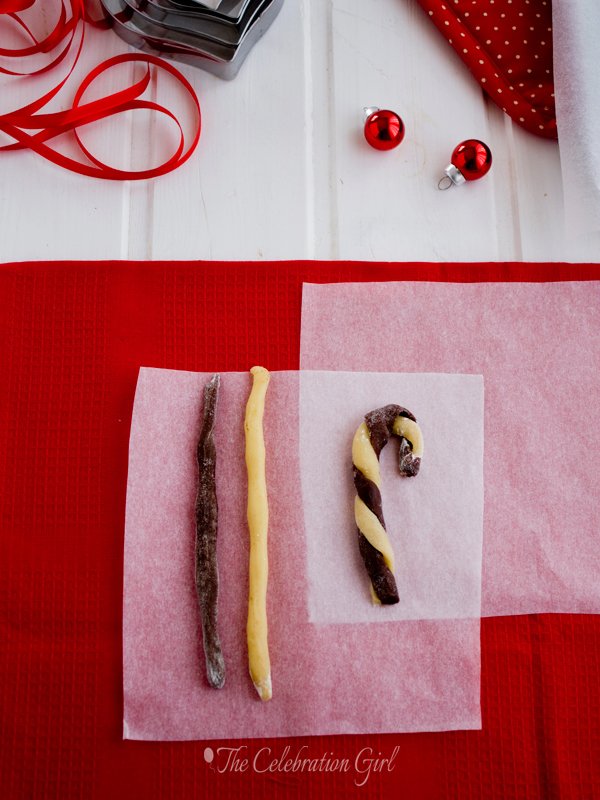
2) Marbled cookies: Take two pieces of dough of different colours, join them by the side and twist a few times. Don’t overdo it or they will merge and you will a have dough in a lighter version of the darker color, not a marbled one. Roll, cut, refrigerate and bake.
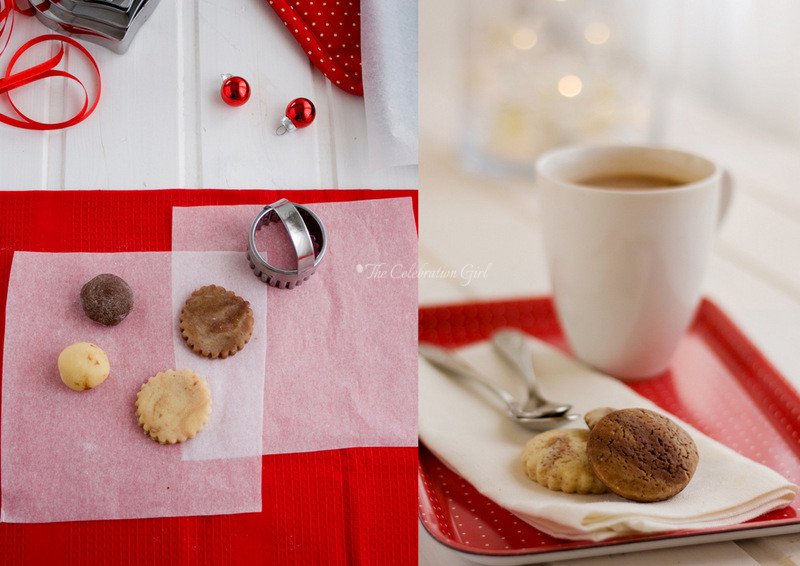
3) Cut out cookie combinations: To make these cookies you will need 2 cookie cutters of the same shape, but different sizes. Roll your cookie doughs and cut a shape with the bigger cutter. Place it in the baking tray and, once there, cut a smaller shape from the same cookie, leaving a “hole” inside. You need to do this when the big cookie is already in the baking tray or it may break or lose shape when transferred. Cut a big cookie of a different color, and repeat the process. Then mix and match the insides. They will merge in the oven and attach to the bigger cookie. Another option that I didn’t have the time to photograph but looks really pretty is to insert crushed hard candy in the hole, to get a vitreau effect. Note: If you don’t have cookie cutters, you can use other utensils. In the past I have used the lid of a marmalade jar to trace a big circle and the lid of a vanilla extract jar to trace the small one.
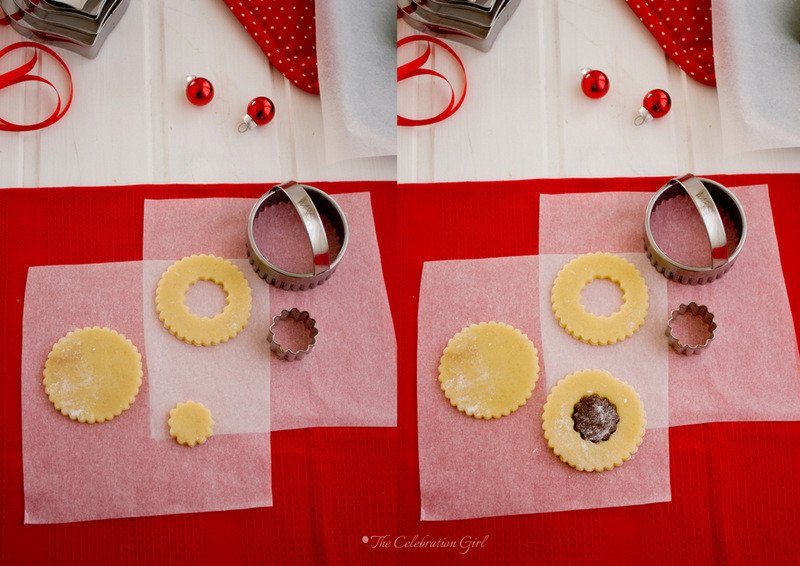

4)3D shape cookies: Cut a small shape in a different color than that of the main cookie, brush it with water and place it on top of the big cookie before baking. They will get attached once baked.
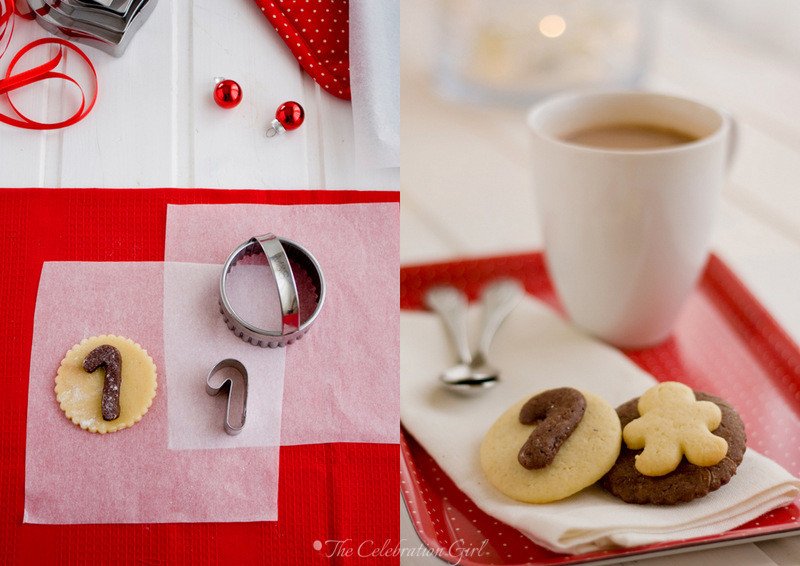
5)Sugar pearls decorated cookies: Did you know that sugar pearls can be added without glaze or icing? They can! Just play with the design and attach them before baking by pressing them lightly into the dough.
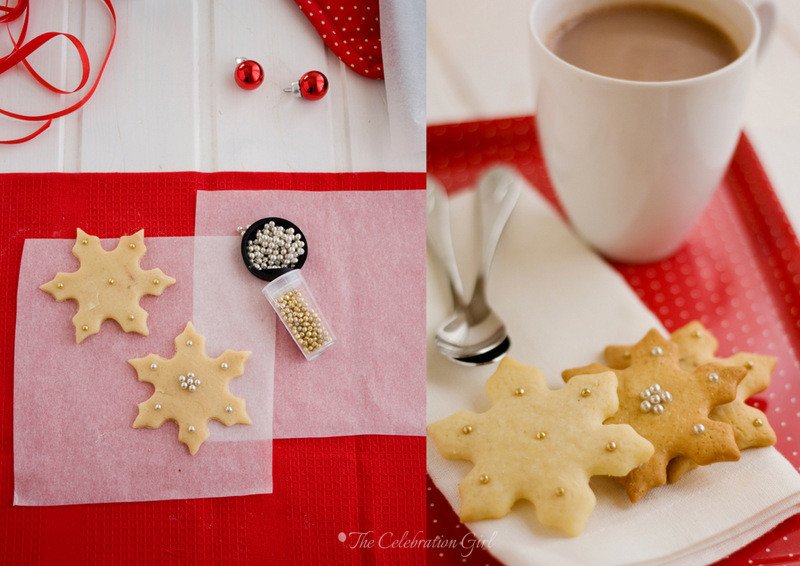
6) Cookie “Truffles”: No, they are not truffles, but they look like them before baking, don’t they? In order to make these cookies, make small balls of dough and roll them in non pareils, sugar pearls, or a combination of 1 tablespooon of sugar, 1/4 teaspoon of cinnamon and a pinch of cardamom before baking. They will expand in the oven,but the colder they are when you start baking them, the more they will keep their shape.
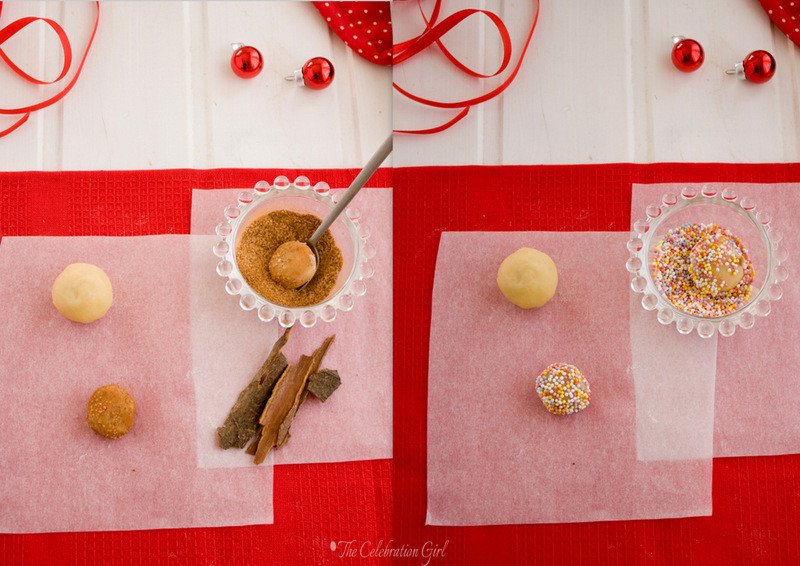
7) Thumbprint cookies or “Pepas”: Pepas is how we call these type of cookies in Argentina and they are normally filled with a square of quince paste, which is a staple food in many Argentinian households (mine is home made, recipe coming soon!). I prefer to make them using the almond shortbread dough, and I like to vary the fillings, using nutella or caramel as well as quince. To make them, roll a ball of dough and press with your thumb (hence the name) or index finger to create a well in the middle. Fill the well with the jam or sweet paste of your choice and bake.
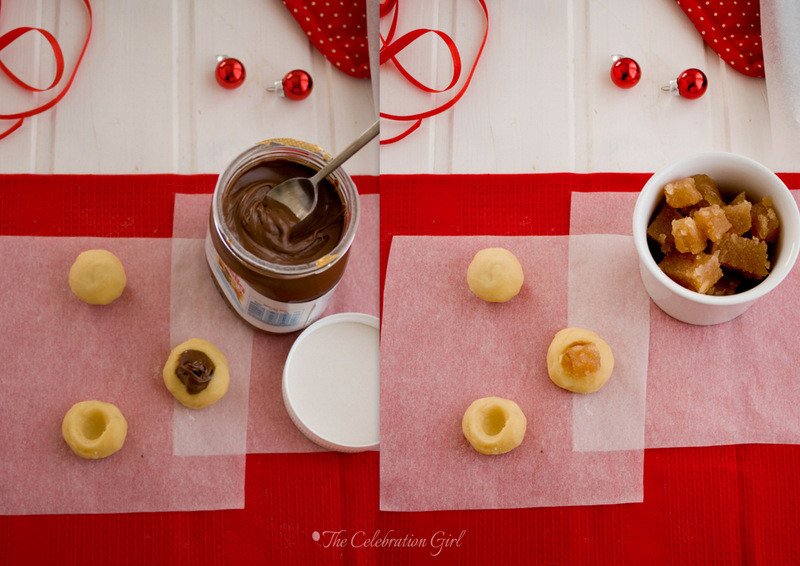
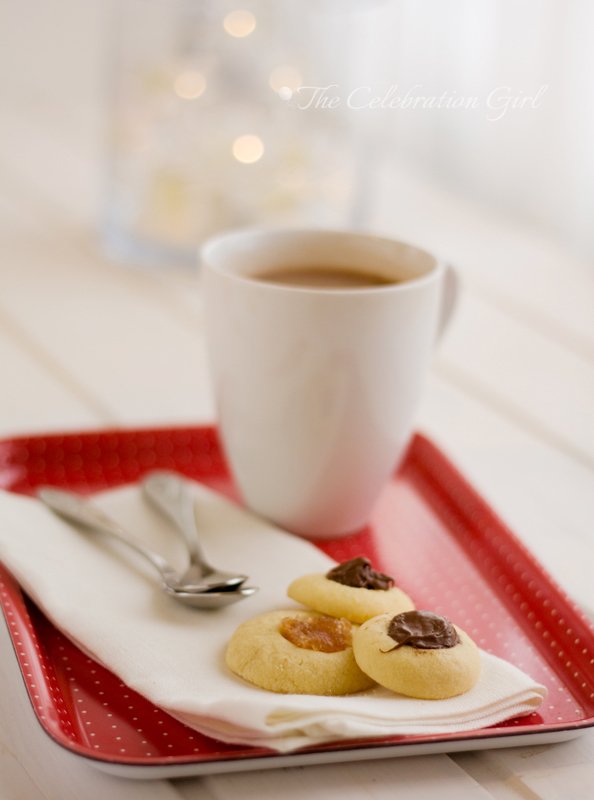
Are you ready to start baking?
Con sabor latino…
Buenos días queridos amigos! Hoy es el 4to día del adviento y faltan sólo 20 días para la nochebuena ¿Pueden creerlo? Sé que lo que voy a decir es un cliché, pero realmente no sé en qué momento pasó el año. Seamos conscientes de la velocidad a la que pasa el tiempo y aprovechemos al máximo este último mes de 2012, si?
Espero que tengan listas las masas de galletitas que compartí con ustedes ayer, porque hoy vamos a usarlas. Así que saquenlas del freezer o heladera y junten sus cortantes, granas, perlas y azucar decorativo porque vamos a comenzar a hacer lindas galletitas surtidas para sus cajitas navideñas.
Hoy vamos a comenzar con las galletitas más fáciles y, en posts sucesivos, les voy a ir mostrando otras maneras de decorarlas, en orden de complejidad creciente. El motivo por el que incluí estas galletitas tan sencillas es porque quiero incentivarlos a cocinar con niños, y estas pueden hacerse aún con los más chiquitos. Ahora bien, al cocinar con niños pequeños, es bueno tener dos cosas en mente: 1) Olvidense del orden y del resultado final. Dejenlos crear. Si queremos galletitas perfectas, podemos hacerlas nosotros solos cuando ellos duermen. Dejemos que cocinar con niños sea un acto creativo, orientado a pasar un momento divertido juntos, a que se familiaricen con los instrumentos de cocina, a que le “agarren el gusto”a cocinar, a construir recuerdos familiares hermosos. 2) Hagan masa extra, porque los chicos son vivísimos y se dan cuenta MUY pronto que la masa de galletitas cruda es deliciosa!
En este post yo usé algunos cortantes que tenía en casa, a modo de ejemplo, pero como verán son posibles muchísimas combinaciones más. Tambien pueden, por ejemplo, teñir parte de la masa de vainilla de otro color, como rojo o verde o cualquier otro que vayan a usar en la decoración, aumentando así las posibilidades creativas. Recuerden, eso sí, que para que las galletitas mantengan su forma es fundamental refrigerarlas, refrigerarlas, refrigerarlas! No omitan este paso!
Ahora sí, vamos a las ideas:
1) Galletas “baston”: No tengo fotos del producto combinado porque mis hijos se las comieron antes que pudiera sacarlas (ejem), pero se ven iguales a la foto del bastoncito armado antes de hornear. Yo usé masas de vainilla y chocolate, pero tambien podrian usar otras combinaciones, como vainilla y gengibre, chocolate y naranja o teñir parte de la masa de rojo y combinarla como un baston de caramelo tradicional. Para hacerlas, tomen una poco de masa de cada color y denle forma de cilindro. Coloquen los dos cilindros, uno al lado de otro, unanlos en la parte de arriba y comiencen a trenzarlos hacia la derecha, pasando la masa de la izquierda por encima de la de la derecha. Una vez trenzados, haganlos rodar un par de veces para que no queden junturas y doblen la parte superior hacia abajo. Corten los bordes para que queden parejos, coloquen en una placa, refrigeren y horneen.
2) Galletas marmoladas:Tomen dos pedacitos de masa de diferentes colores, unanlos por el costado y retuerzanlos un par de veces. No retuerzan mucho o en lugar de galletitas marmoladas tendrán simplemente una masa de color más claro que la oscura. Estiren con palote, corten, coloquen en una placa, refrigeren y horneen.
3) Galletas combinadas: Para hacer estas galletitas necesitarán dos cortantes de igual forma pero de distinto tamaño. Hacerlos es muy sencillo: estiren una de las masas con palote y corten galletitas con el cortante más grande. Coloquen las galletitas en la placa y, una vez allí, usen el cortante pequeño para sacar una galletita mas pequeña del centro de la más grande. Les sugiero hacerlo una vez que la galletita grande ya esté en la placa porque, de lo contrario, ésta puede romperse o perder la forma al transferirla ya cortada. Luego, repitan el proceso con la masa del otro color e inviertan los centros. Las dos partes se unirán al hornear, dejandoles una galletita divertida de dos sabores y colores. Otra opción muy linda que no tuve tiempo de fotografiar es colocar caramelo duro picado (destrozado con mortero) en el hueco, para lograr un efecto vitreau. Nota: si no tienen cortantes de galletitas, pueden usar otros instrumentos de cocina. En el pasado yo he hecho estas galletitas usando la tapa de un frasco de mermelada para el circulo grande y la tapa de un frasco de esencia de vainilla para el más pequeño.
4) Galletas con formas en 3D: Sencillísimas, sólo hay que cortar una formita en un color de masa diferente al de la galleta principal, y pegarla con agua a la más grande antes de hornear ( Se unirán en el horno)
5) Galletas decoradas con perlas de azucar: ¿Sabían que no hace falta glasa ni glacé para pegar perlas de azucar? Pues así es! Solo tienen que colocarlas sobre la masa cruda, conforme el diseño que prefieran, y presionar apenas con el dedo sobre las mismas para insertarlas en la masa. Luego refrigeren, horneen y listo.
6) “Trufas”de galletita: No, no son verdaderas trufas pero lo parecen antes de ser horneadas, no? Para hacerlas, hagan una bolita de masa, y ruedenla en granas, nonpareils, perlas de azucar o en una combinación de 1 cucharada de azucar, 1 cuarto de cucharadita de canela molida y 1/8 de cucharadita de cardamomo. Se expandirán en el horno, pero tienden a conservar mejor la forma cuanto más fría está la masa.
7) Pepas: Estas galletitas son muy comunes en Argentina, rellenas con un cuadradito de dulce de membrillo (que es un clásico de nuestra gastronomía). Mi dulce de membrillo es casero y la receta será publicada pronto! Yo prefiero hacer estas galletitas con la receta de las galletitas mantecosas de almendra, que compartí con ustedes ayer, combinando distintos sabores para el relleno. El clásico membrillo, nutella o salsa de caramelo quedan deliciosos. Para hacerlas, hagan una bolita de masa y, luego, presionen con el pulgar o el índice para ahuecar la masa en el centro, y rellenen el mismo con el dulce o mermelada deseado. Refrigeren, horneen, y listo!
Estan listos para empezar a hornear?
by Marcela M. | Dec 3, 2012 | Blog, Christmas and NYE, cookies, Cooking basics and tutorials, Holidays, Recipe Box, Recipes, Sweets
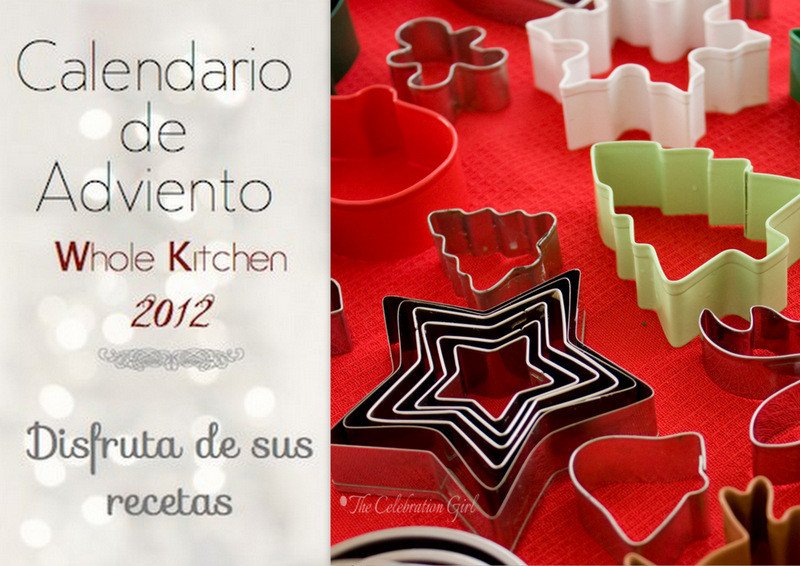
Good morning friends! I hope you had a lovely weekend!
Today’s post participates in Whole Kitchen’s 2012 Advent calendar . A few days ago, Silvia contacted me to offer me to participate in it and I, of course, accepted! So today, get your aprons ready because we start baking! (Amigos hispanoparlantes, el texto en español está al final del post!)
I thought it was best to begin the holiday baking season with the basics: 3 simple cookie recipes and a few explanations on how to adapt they are adapted. I wanted to give you my staple recipes, the ones that are simple enough to make in whim, yet delicious, reliable and versatile to allow multiple modifications. In following posts, I will show you a few ideas for combining and decorating them, with varying degrees of difficulty, so that you can make a box of assorted cookies without spending days in the kitchen.
Let’s get started!
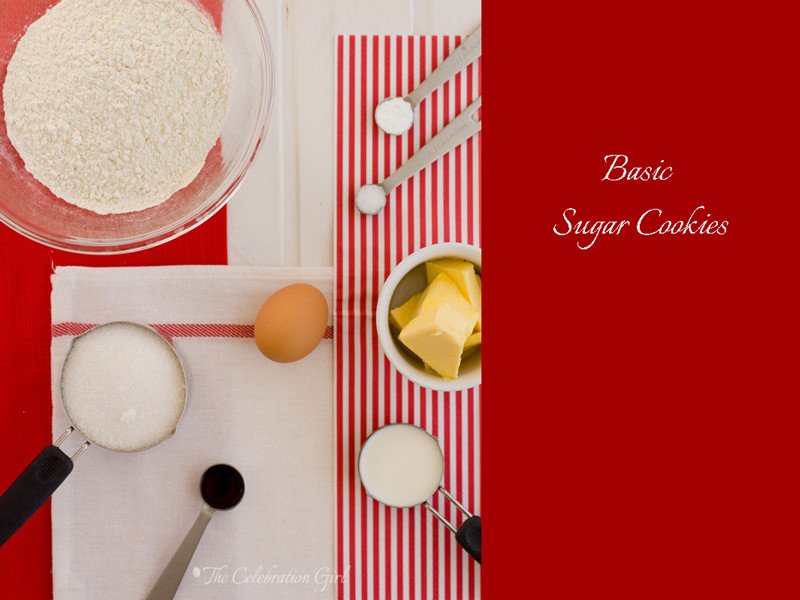
The first recipe is for the all time classic Sugar Cookie. The first time I made them was just a few years ago, inspired by some of my favorite bloggers and following to the letter the recipe for Martha Stewart’s Ideal Sugar Cookies. As time went by, I introduced a few little modifications: I normally double the amount of vanilla and, if baking with my children, who love to spread flour everywhere, I add more milk than usual to prevent the cookies from becoming too hard once baked. Also, since my son doesn’t tolerate dairy products too well, I frequently use margarine instead of butter, and vegetable milk instead of cow’s milk. The texture is different when baking with margarine, but the recipes turn out delicious nonetheless. One important note, though, is that margarine should not be beaten extensively or the final product becomes oily (and we don’t want that!). So, if that’s what you are using, cream it with sugar for a maximum of 3 minutes.
Take this as your basic recipe, and then start playing with it. You could use it as a basis for making sugar orange or lemon cookies, for example, by simply adding a teaspoon of orange or lemon zest and replacing the milk for lemon or orange juice, or you could make coffee flavored cookies by replacing 1 teaspoon of the milk for espresso. The possibilities are really endless. Just make sure that you maintain the balance between liquid and dry ingredients and that your replacements respect the original ratios.
Here’s the basic recipe (adapted from Martha Stewart):
Ingredients: 2 cups all purpose flour, 1/4 tsp salt, 1/2 tsp baking powder, 113 grs butter (1/2 cup) or margarine , 1 cup sugar, 1 beaten egg, 4 tbp milk or 1/4 cup milk ( this is the amount I use when I bake with my children because I know they will add too much flour when rolling and cutting. Please note that Martha’s original recipe calls for 2 tablespoons only), 1 teaspoon vanilla extract.
Preparation: 1) Pre heat the oven to 175 C. 2)Cream butter and sugar until the butter becomes almost white. Note that if you are using margarine, you should cream it for a maximum of 3 minutes 2) Add milk, vanilla and the beaten egg. Incorporate. 3) Whisk or sift together the dry ingredients: flour, salt and baking powder and add them to the batter, making sure not to overmix. 4) Extend plastic wrap on the kitchen’s counter, pour the dough in it, wrap it and refrigerate for a couple of hours. If you are baking this cookies in the summer and you live in very hot climates, I recommend putting it in the freezer for 1 hour instead. 5) When you are ready to bake the cookies, flour the kitchen counter, and roll using a rolling pin, considering that thicker cookies are moister and chewier, and thinner cookies are crispier. Cut the cookies using a cookie cutter or a knife, place on a baking sheet covered in baking paper and refrigerate. Do not skip the refrigerating step or your cookies will lose shape in the oven! I normally place them in the freezer for 20 minutes before baking. 6) Bake for 10-15 minutes. Do not let them brown.Let cool on a wire rack and eat or decorate.

Now let’s say you want to make chocolate sugar cookies instead, how do you adapt the basic recipe? It’s also very simple. As you can see from the pictures above, most ingredients remain the same, and a few new ones are added, namely cocoa, brown sugar and an extra egg to make up for the added dryness. Remember, it is a matter of ratios and balance between the different ingredients. Cocoa is a dry ingredient, so it counts as if we had increased the amount of flour. Brown Sugar gives the recipe a darker color, a stronger flavour (because it contains molasses) and, as sugar in general, acts as a binding agent. Having added these two ingredients, the recipe would be too dry if you didn’t add an extra egg, but if you prefer to keep the quantities intact and you don’t want to add an extra egg, you could do so by reducing 20% of the flour and replacing it by cocoa, and replacing 1/3 of the granulated sugar and replacing it with brown sugar. That is really all it takes.
Here’s the recipe (as I normally do it)
Ingredients: 2 cups flour, 1/2 cup cocoa, 1/2 tsp baking powder, 1/4 tsp salt, 113 grs butter or margarine, 1 cup granulated sugar, 1/3 cup brown sugar, 2 beaten eggs, 2 teaspoons milk, 1 teaspoon vanilla.
Preparation: 1) Pre heat the oven to 175 C. 2)Cream butter and the two sugars until light and fluffy. Note that, if you are using margarine, you should cream it for a maximum of 3 minutes 2) Add milk, vanilla and the beaten eggs. Incorporate. 3) Whisk or sift together the dry ingredients: flour, cocoa,salt and baking powder and add them to the batter, making sure not to overmix. 4) Extend plastic wrap on the kitchen’s counter, pour the dough in it, wrap it and refrigerate for a couple of hours. If you are baking this cookies in the summer and you live in very hot climates, I recommend putting it in the freezer for 1 hour instead. 5) When you are ready to bake the cookies, pour cocoa powder on the kitchen counter. I prefer to use cocoa instead of flour when making chocolate cookies because this prevents them from getting a white coat and accentuates the flavor 6) Roll using a rolling pin, considering that thicker cookies are moister and chewier, and thinner cookies are crispier. 7) Cut the cookies using a cookie cutter or a knife, place on a baking sheet covered in baking paper and refrigerate. Do not skip the refrigerating step or your cookies will lose shape in the oven! I normally place them in the freezer for 20 minutes before baking. 8) Bake for 10-15 minutes. Do not let them brown.Let cool on a wire rack and eat or decorate.
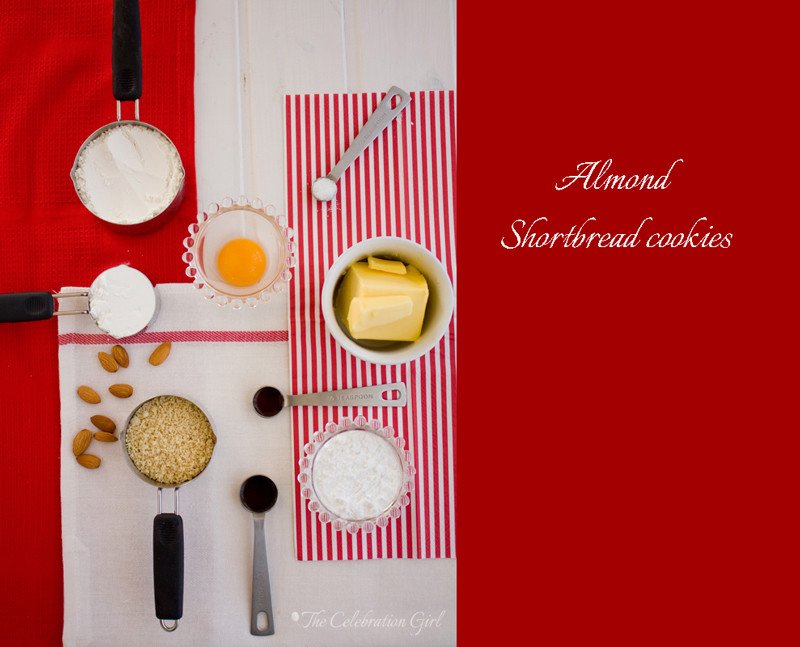
Today’s final recipe is another holiday classic, shortbread cookies, that I have adapted by including finely ground almonds in it. The main difference between sugar and shortbread cookies lies in the proportion between butter and sugar: Sugar cookies use double the amount of sugar than that of butter, and in shortbread cookies this ratio is reversed. Notice also that, in this recipe we also reduce 1/8 of the amount of dry ingredients (almonds count as dry ingredients and so does cornstarch) and that there’s a correlative reduction in the wet ingredients: instead of one egg, we use only an egg yolk and we omit the milk altogether. These cookies don’t require baking powder either, so they won’t rise. The result is a richer cookie, with a softer flavor, ideal for combining with fillings and chocolate.
As I mentioned before, I have modified this recipe by using almonds and almond extract, but you could omit them and use only flour, or replace these with other nuts (hazelnuts are also delicious).
Here’s my recipe for Almond shortbread cookies:
Ingredients: 1 cup flour, 1/2 cup finely ground almonds, 1/2 cup icing sugar, 1/4 cup cornstarch, 1/4 tsp salt, 113 grs butter, 1 egg yolk, 1/2 teaspoon vanilla, 1/2 teaspoon almond extract
Preparation: 1) Put the finely ground almonds, flour, cornstarch, salt and icing sugar in the food processor and pulse until combined. 2) Add the wet ingredients and pulse until the dough separates from the bowl 3) Remove the dough from the food processor and knead it on the counter. 4) Cover in plastic wrap and refrigerate for two hours. 5) Pre heat the oven to 175 C. Remove the dough from the refrigerator, roll on a floured surface and cut in the desired shapes. Place the cookies on a baking sheet lined with baking paper and bake for 10-15 minutes. Let cool on a wire rack and eat or decorate.
Tomorrow I’ll start showing you some ways in which you can play with these recipes!
Now, please tell me: Do you bake cookies for the holidays? What are your favorite recipes? Do you like to decorate them and, if so, how do you do it?
Have a lovely Monday!
Con sabor latino…
Buenos días queridos amigos y bienvenidos sean todos aquellos nuevos lectores que llegan desde Whole Kitchen! Espero que hayan pasado un hermosísimo fin de semana.
El post de hoy participa en el Calendario de Adviento 2012 de Whole Kitchen . Hace unos días, Silvia me contactó para preguntarme si quería participar en el mismo y yo, por supuesto, acepté! Así que preparen sus delantales, porque hoy vamos a hornear!
Para inaugurar la temporada de cocina de la época navideña, pensé que sería mejor empezar por la base: 3 recetas simples y un par de explicaciones acerca de cómo introducir variaciones a las mismas. Quise compartir con ustedes aquellas recetas a las que vuelvo una y otra vez, aquellas que son lo suficientemente simples como para hacer en menos que canta un gallo, a la vez que confiables, deliciosas y versátiles como para permitir que cada uno deje volar su creatividad. En posts sucesivos voy a mostrarles ideas de cómo combinarlas y cómo decorarlas con distintos grados de dificultad, para que estas fiestas puedan tener una caja de galletitas variadas sin necesidad de pasar horas y horas en la cocina.
Comencemos!
La primera receta que quiero compartir con ustedes es la de las clásicas galletitas de azucar. La primera vez que la hice fue apenas unos años, y en esa ocasión y muchas otras, seguí al pie de la letra ESTA receta de la inigualable Martha Stewart. A medida que el tiempo pasó, fui introduciendo algunas modificaciones, por ejemplo suelo duplicar la cantidad de vainilla y, si preparo la receta con mis hijos, suelo duplicar la cantidad de leche porque tienden a agregar mucha harina cuando estiran la masa y me ha ocurrido que si sigo la receta al pie, quedan un poco duras. Tambien suelo hacerlas con margarina y leche vegetal porque mi hijo, sin llegar a ser alergico, nunca a tolerado muy bien que digamos los lacteos. Debo aclarar que la textura resultante es un poco diferente cuando uno trabaja con margarina, pero creanme que son deliciosas de todas maneras. Una advertencia importante, sin embargo, es que la margarina no debe batirse mucho tiempo con el azucar, como hacemos con la manteca, porque si no las galletas resultaran oleosas. Si usan este ingrediente, recuerden no batirla más de 3 minutos.
Les sugiero tomar esta receta como base y luego experimentar con otros sabores. Por ejemplo, si quieren hacer galletitas de limon o de naranja, pueden agregar una cucharadita de té de ralladura de limón o naranja, y reemplaza la leche por jugo de limón o naranja. Si quieren hacer galletitas de café, pueden reemplazar una cucharada de leche por una de café espresso…y así sucesivamente. Las posibilidades son enormes! Sólo tengan en cuenta que, para que la receta resulte bien, es necesario mantener el equilibrio entre los ingredientes secos y líquidos, y que los reemplazos mantengan las raciones originales.
Esta es la receta para las galletitas de azucar básica (adaptada de Martha Stewart)
Ingredientes:2 tazas de harina todo uso, 1/4 cucharadita de sal, 1/2 cucharadita de levadura química (Polvo de hornear Royal), 113 grs de manteca o margarina vegetal, 1 taza de azucar blanca, 1 huevo batido, 4 cucharadas o 1/4 taza de leche (puede ser vegetal. Tengan en cuenta que la receta original sólo requiere dos cucharadas y que yo sólo la duplico porque mis hijos tienden a agregar demasiada harina luego. Si no cocinan con niños o si sus niños son disciplinados al agregar harina, es mejor mantener la cantidad original), 1 cucharadita de vainilla.
Preparación: 1) Bata la manteca pomada con el azucar hasta que la preparación resulte en una crema blancuzca y esponjosa 2) Agregue leche, vainilla, y el huevo batido e incorpore 3) Mezcla con batidor de alambre o cierna los ingredientes secos: harina, sal y levadura química, y agreguelos en dos veces. Mezcle sólo hasta que todos los ingredientes estén incorporados. 4) Envuelva la masa en papel film y lleve al refrigerador por al menos dos horas. Si están haciendo esta receta en verano o en climas muy cálidos, yo prefiero poner la masa una hora en el freezer. Es más facil trabajarla luego! 5) Cuando quiera hornear las galletas, retire la masa del freezer y estirela con palote sobre una superficie lisa. Tenga en cuenta que si la estira levemente gruesa las galletitas resultaran mas humedas, y si la estira finita, resultaran crocantes. 6) Corte las galletitas usando un cortante especial o cuchillo, colóquelas sobre una placa para horno cubierta con papel de hornear y refrigere. Es muy importante que no omita este paso! Si las galletitas no son refrigeradas pierden la forma en el horno! Yo suelo colocar la placa en el freezer durante 20 minutos para obtener mejores resultados. 7) Hornee a 175 C durante 10/15 minutos. No deje que tomen color (eso las vuelve duras). Deje enfriar sobre una rejilla y coma o decore.
Ahora bien, digamos que queremos hacer galletitas de chocolate ¿cómo transformamos la receta original? Es de verdad muy sencillo. Como pueden ver si comparan las dos primeras fotos, la mayor parte de los ingredientes se mantienen constantes y sólo se agregan tres: cacao, azucar morena, y un huevo más para compensar por las nuevas adiciones. Recuerden que modificar recetas es una cuestión de mantener proporciones y equilibrio entre los diferentes ingredientes. Como el cacao es un ingrediente seco, su adición cuenta como si hubieramos agregado harina. El azucar moreno cambia el sabor de la receta (porque contiene melaza), contribuye a que las galletitas tengan un color más oscuro y, como todo azucar en general, ayuda a que los ingredientes “liguen”. Habiendo agregado estos ingredientes, es necesario entonces sumar un huevo más para que la masa no resulte seca. Ahora bien, si prefieren usar uno solo (cuantas veces nos hemos encontrado con un solo huevo en la cocina, verdad? Yo,muchas!), modifiquen las cantidades de harina y de azucar blanca: reduzcan 20% la cantidad de harina y reemplacenla por cacao, y reduzcan 1/3 de la cantida de azucar blanca y reemplacenla por azucar moreno. Es tan sencillo como eso!
Esta es mi receta para galletitas de chocolate
Ingredientes:2 tazas de harina todo uso, 1/2 taza de cacao amargo, 1/4 cucharadita de sal, 1/2 cucharadita de levadura química (Polvo de hornear Royal), 113 grs de manteca o margarina vegetal, 1 taza de azucar blanca, 1/3 taza de azucar morena, 2 huevos batidos, 2 cucharadas de leche (puede ser vegetal), 1 cucharadita de vainilla.
Preparación: 1) Bata la manteca pomada con los dos azucares hasta que la preparación resulte esponjosa. Recuerden no batir más de 3 minutos si usan margarina 2) Agregue leche, vainilla, y los huevos batidos e incorpore 3) Mezcla con batidor de alambre o cierna los ingredientes secos: harina, cacao, sal y levadura química, y agreguelos en dos veces. Mezcle sólo hasta que todos los ingredientes estén incorporados. 4) Envuelva la masa en papel film y llevela al refrigerador por al menos dos horas. Si están haciendo esta receta en verano o en climas muy cálidos, yo prefiero poner la masa una hora en el freezer. Es más facil trabajarla luego! 5) Cuando quiera hornear las galletas, retire la masa del freezer y estirela con palote sobre una superficie lisa. Tenga en cuenta que si la estira levemente gruesa las galletitas resultaran mas humedas, y si la estira finita, resultaran crocantes. 6) Corte las galletitas usando un cortante especial o cuchillo, colóquelas sobre una placa para horno cubierta con papel de hornear y refrigere. Es muy importante que no omita este paso! Si las galletitas no son refrigeradas pierden la forma en el horno! Yo suelo colocar la placa en el freezer durante 20 minutos para obtener mejores resultados. 7) Hornee a 175 C durante 10/15 minutos. No deje que tomen color (eso las vuelve duras). Deje enfriar sobre una rejilla y coma o decore.
La última receta que les traigo hoy es la de otro clásico de está epoca: las galletitas de manteca o shortbread cookies, la que yo he modificado para transformarla en galletitas mantecosas de almendras. La diferencia principal entre las galletitas de azucar y las de manteca radica en la proporción entre estos dos ingredientes: las galletitas de azucar usan el doble de azucar que de manteca, y en las de galletitas de manteca esta proporción se invierte. Noten tambien que en estas galletitas reducimos 1/8 la cantidad de ingredientes secos, y teniendo en cuenta todo lo anterior (menos ingredientes secos y menos azucar), debemos reducir tambien los ingredientes líquidos, por lo que en lugar de un huevo entero usaremos sólo una yema, y omitiremos la leche. Las galletitas resultantes son más densas y de un sabor más neutro, no tan dulces,por lo que son ideales para combinar con rellenos y chocolate.
Como mencioné antes, yo he modificado la receta incluyendo almendras molidas en la misma. Si prefieren no hacerlo, pueden reemplazar la cantidad de las mismas por harina común (todo uso), bien pueden experimentar con otras nueces (yo las hecho tambien con avellanas molidas y quedan muy bien, por ejemplo).
Aquí está mi receta para galletas de almendras y manteca:
Ingredientes: 1 taza de harina, 1/2 taza de almendras molidas bien finitas, 1/4 taza de almidon de maiz (maizena), 1/2 taza de azucar impalpable, 1/4 cucharadita de sal, 113 grs de manteca, 1 yema de huevo, 1/2 cucharadita de extracto de vainilla, 1/4 cucharadita de extracto de almendras.
Preparación: 1) Coloque almendras, harina, sal, azucar y almidón de maiz en el bowl de la procesadora y pulse hasta que estén bien combinados. 2) Agregue todos los ingredientes húmedos (manteca, huevo y extractos) y pulse hasta que la masa se separe de las paredes del bowl. 3) Retire la masa de la procesadora y trabajela sobre la mesada hasta formar un bollo. 4) Envuelva la masa en papel film y lleve al refrigerador por dos horas. 5) Espolvoree harina sobre una superficie lisa, y estire la masa con palote. Corte de la forma deseada, coloque en una placa para horno cubierta con papel de hornear y hornee a 175 C por 10-15 minutos. No deje que tomen color. Deje enfriar sobre una rejilla y coma o decore.
Mañana comenzaré a mostrarles algunas formas en que pueden jugar con estas recetas.
Ahora cuentenme: ¿hornean galletitas para las fiestas? ¿cuales son sus recetas favoritas? ¿suelen decorarlas y de qué manera?
Que tengan un hermoso día lunes!
by Marcela M. | Oct 22, 2012 | Blog, cookies, Holidays, Recipe Box, Recipes, Sweets, Uncategorized
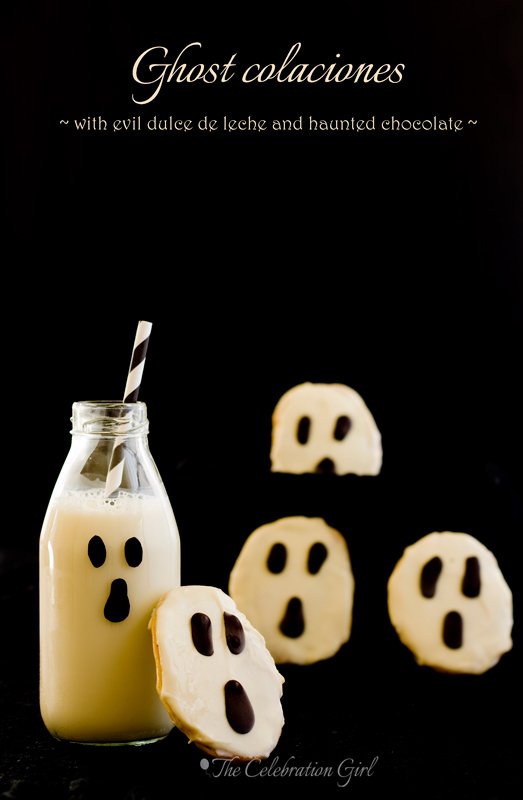
Good evening friends! Can you believe that it’s only 9 days until Halloween? I know I can’t, but I’m excited about it! This is going to be our children’s first full costume and trick or treat celebration, and I’m eager to see how they respond to all the activities at school.The holiday, I should note, is not celebrated in Cyprus (no trick or treating from door to door), but they will have a special party at their nursery and it promises to be fun. I bought their outfits earlier today…and I hope they will agree to wear them! 🙂
Halloween was not celebrated massively in Argentina either, when I was growing up, but my mother did organize a party every year at the institute for learning English as a second language, which she owned. So, every October 31st, her students and us (her children) dressed up in spooky costumes and celebrated it. It was all very funny because October is Springtime in Argentina and, of course, there were no pumpkins to carve at this time of the year, nor did any shops have any decorations that we could use, so we had to do as we could with a few sheets of black and orange cardboard paper. I still smile when I remember how crazy people thought we all we were, walking dressed as ghosts, witches, pirates and skeletons, on our way to the house where the party was held.
Things have changed in the last 20 years (20 YEARS!!), and Halloween parties are more popular, but, in the spirit of those first celebrations I attended, I thought it would be fun to use this opportunity to share with you the recipe for a delicious, classic cookie from Cordoba, Colaciones, and to “halloweenize” it ( I just invented that word :))
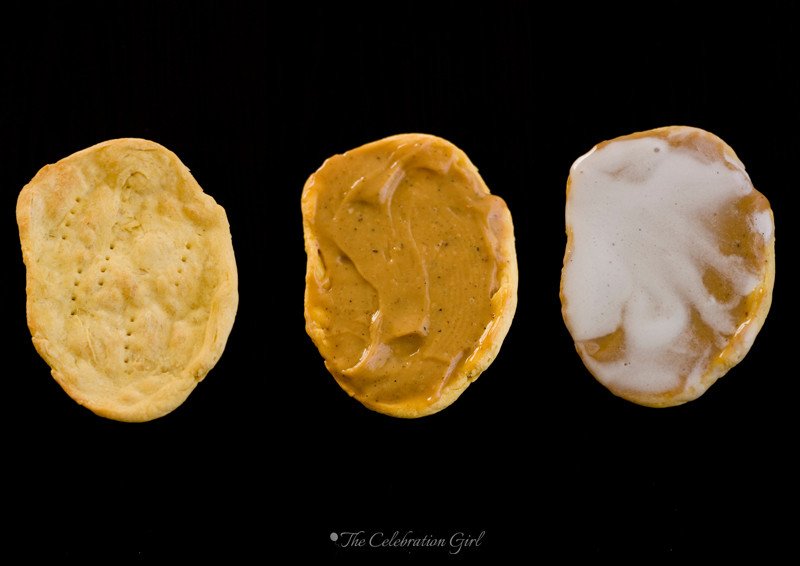
This recipe has been adapted from the one of a famous Argentinian pastry chef called Maru Botana (you can find the original one here), and it is the best one I ever tried. Colaciones’ dough is very peculiar: it doesn’t take any oil or butter, nor does it take any sugar or salt It is just a combination of eggs, egg yolks, flour and a white alcoholic beverage of your choice (the original recipe calls for cherry brandy, but you can also use another type of brandy or gin or vodka). Eggs are beaten, flour and brandy is added and then the dough is kneaded and shaped in the traditional way. One word of caution: do not put the dough in the freezer! I did it because I didn’t have time to finish making them in the same day, and when I thawed it, I had to start all over, because it had become too hard. If you need to make the colaciones in advance, it is better to prepare the dough and bake the cookies in one take. You can store the already baked shells in an airtight container (such as freezer bags), and then fill them with dulce de leche (as is traditional in Córdoba) or quince jam (as they do in some Northern cities of Argentina) and glaze them a few hours before it’s time to serve them.
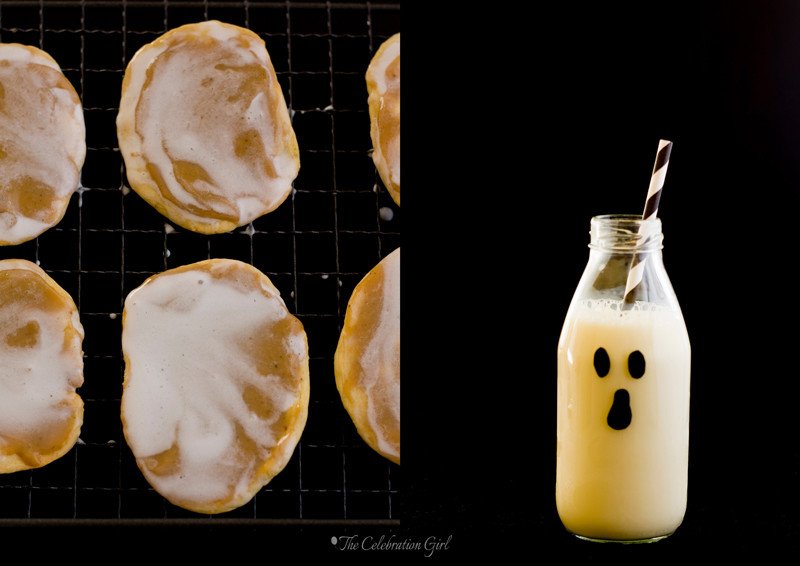
Colaciones’ traditional glaze is a simple combination of a beaten egg white, icing sugar and boiling water. In this occasion, however, I chose to cover them in white chocolate for a smoother, more even finish, because I didn’t want the dulce de leche to be visible. Then, I drew a ghostly face with dark chocolate, using just a regular teaspoon (no fancy decorating items required!). So, if you are looking for an easy, delicious, untraditional sweet for your Halloween celebrations, give colaciones a try! You will love them!
Here’s the recipe:
Colaciones cordobesas (makes 64 cookies of approximately 5 cms) Recipe adapted and translated from Maru Botana’s
Ingredients: 2 eggs, 4 egg yolks, 1 tablespoon of brandy/gin/vodka, 300 grs all purpose flour, 500 grs dulce de leche (if you can find dulce de leche repostero/baker’s dulce de leche, it is better, but any other will work as well), 1 beaten egg white, 2 cups of icing sugar, 2 tablespoons of boiling water (alternatively, if you want to glaze them with white chocolate, you will need approximately 600 grs and 200 grs dark chocolate to draw the spooky face in all 64 cookies).
Preparation: Beat eggs and egg yolks to the ribbon (it takes about 10 minutes). Add flour and brandy, mixing well, until you get a workable ball of dough. Knead the dough and extend it with a rolling pin. Cut the cookies using a round cookie cutter and then work each with your hands, to extend them and make them thinner (as thin as possible, or they will be too hard once baked). The dough is hard to work with, shaping the cookies takes some effort!. Once they are thin, place them on a baking tray covered with baking paper, and pinch them with a fork. Bake them at 175C for about 10 minutes. They will dry and curve in the oven and, once they do this, they are ready. Remove from the oven, let them cool well and fill with a teaspoon of dulce de leche. Next, prepare the glaze of your choice. For the traditional glaze, beat an egg white until firm, add two cups of sugar to “dry”the egg white and then, slowly, add the boiling water. I needed two tablespoons, but you may need more or less, so do it slowly. If you notice that the glaze is too thin and won’t cover the cookies properly, you may add more icing sugar. Note, however, the traditional glaze does not provide an all white, perfect coverage so, if that’s what you are aiming for, I suggest covering the cookies in white chocolate instead. Whichever glaze you chose, let it harden before drawing the spooky face on it.
Decoration: Melt dark chocolate and and let it cool down. Once it’s cool, draw a ghostly face on the cookies, by adding little bits of chocolate with a teaspoon.
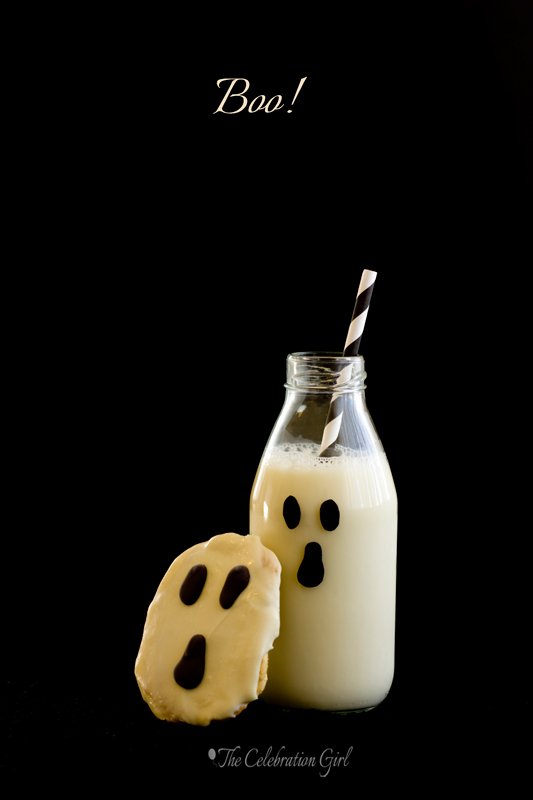
Con sabor latino…
Buenas noches amigos! ¿Pueden creer que faltan apenas 9 días para Halloween? A mí me resulta increible, pero en casa estamos super excitados al respecto porque esta va a ser la primera vez que Luka y Zoe van a festejarlo con disfraces y golosinas, y tenemos muchas ganas de ver cómo reaccionan ante todo el despliegue de actividades que están organizando en su escuela. En Chipre no se festeja Halloween masivamente, como en otros países, así que no hay pedidos de golosinas a los vecinos ni nada de eso, pero sí van a tener su primera fiesta en la escuela, y promete estar divertida. Esta mañana, sin ir más lejos, les compré sus primeros disfraces- ahora sólo queda esperar que ;es gusten y se los pongan!
Halloween tampoco se celebraba mucho en Argentina, cuando yo era adolescente, pero mi mamá sí organizaba una fiesta todos los años, en su instituto de inglés. Así que, cada 31 de octubre , sus alumnos y nosotros (sus hijos), nos disfrazábamos y lo celebrábamos. Era todo muy gracioso porque, como octubre es primavera en Argentina, no había zapallos que decorar, y al no ser una fiesta tradicional nuestra, tampoco había en los negocios golosinas especiales, ni decoraciones alegóricas, así que nos arreglábamos simplemente con algunas cartulinas negras y naranjas, y el talento de mi madre para transformar el salón en dos segundos, con lápices y tijeras. Escribo estos recuerdos y sonrío pensando en cómo la gente nos miraba como si estuvieramos locos, al vernos caminar hacia el instituto de inglés vestidos como brujas, fantasmas, y esqueletos.
Todo esto ha cambiado en los últimos 20 años (20 AÑOS!) y ahora Halloween es mucho más común pero, en honor a esos primeros festejos de mi vida, se me ocurrió aprovechar esta ocasión para traerles una receta tradicional Argentina (Cordobesa!) y “halloweenizarla” (sí, inventé esa palabra :))
La receta de hoy ha sido adaptada de la de Maru Botana, una famosa chef pastelera Argentina, y es sin dudas la mejor que he probado. La masa de las colaciones es muy peculiar: no lleva aceite, ni manteca, ni azucar, ni sal. Es sólo un conjunto de huevos, yemas, harina y algún licor blanco de su elección. La receta original de Maru lleva aguardiente de cerezas, pero yo la he hecho también con brandy, gin o vodka. El procedimiento consiste en batir mucho huevos y yemas (aproximadamente 10 minutos con batidora), hasta lograr el punto “letra”, que es cuando al levantar el batidor se forma una cinta de liquido que no se corta, y con la cual puede dibujarse sobre el resto de la preparación (=formar letras). Luego, se agregan harina y aguardiente y se forma n bollo de masa, que se estira, se corta y se da forma con las manos antes de llevar al horno. Aprovecho para hacerles una advertencia: no coloquen la masa en el freezer. Si no tienen tiempo de hacer todas las colaciones en un mismo día, es preferible que hagan la masa, y cocinen las galletitas en el momento, y luego las guarden en el freezer, ya cocidas, en un recipiente hermético o en bolsas especiales. Luego, pueden descongelarlas dentro del recipiente, y retirarlas unas horas antes de servir, para rellenarlas con dulce de leche (como en Cordoba) o con dulce de membrillo (como en algunas provincias del norte de Argentina) y cubrirlas con glaseado.
El glaseado tradicional de las colaciones es uno muy simple a base de clara batida a punto nieve, azucar impalpable y agua hirviendo. En esta ocasión, sin embargo, yo elegí cubrirlas con chocolate blanco para darles un finalizado más parejo y uniforme, ya que no quería que se transparentara el dulce de leche del relleno. Luego, derretí chocolate negro y dibujé la carita del fantasma con el mismo, usando una cuchara de café (no hace falta manga ni nada especial!). Si estan buscando una receta diferente para sus celebraciones, prueben estas colaciones que seguro les encantan!
Para ver la receta original, hagan click en ESTE LINK. Normalmente no suelo publicar recetas de otros autores y el unico motivo por el que lo hago en esta ocasión es porque he agregado notas a la forma de preparala y precisado cantidades de glaseado, que quiero compartir con ustedes, y creo que sería muy confuso tener que ver dos páginas al mismo tiempo para entender una receta. Sin embargo, no dejen de ver la pagina de Maru, porque tiene unas recetas fantasticas y precisas, que vale la pena intentar!
Colaciones cordobesas (para 64 galletitas, aproximadamente), adaptada de una receta original de Maru Botana
Ingredientes: 2 huevos, 4 yemas, 1 cucharada sopera de brandy/aguardiente/gin/vodka, 300 grs de harina común (todo uso), 500 grs de dulce de leche (si consiguen dulce de leche repostero, mejor, pero si no el otro sirve igual), 1 clara batida a nieve, 2 tazas de azucar impalpable, 2 cucharadas soperas de agua hirviendo. Si quieren cubrirlas con chocolate blanco, como hice yo, necesitaran 600 grs del mismo para todas las galletitas, y 200 grs de chocolate negro para dibujar la carita fantasmagórica.
Preparación: Batan los huevos y las yemas a punto letra, aproximadamente 10 minutos con batidora. Agregue el brandy y el harina, de a poco, integrando bien, hasta que pueda formar un bollo de masa con las manos. Estiren con palote de amasar y corten circulos con un cortante redondo (yo use uno de 4 cms). Luego, trabajen la masa con los dedos (vean la foto de más arriba), estirandola para que quede bien finita. Cuiden que la masa quede bien fina, porque si está demasiado gruesa, las colaciones quedarán duras unas vez cocidas. Les advierto que la masa es dura y darles forma requiere esfuerzo! Una vez que esten bien finitas, coloquenlas en una placa para horno cubierta con papel de hornear, y pinchenlas con el tenedor. Cocinenlas a 175C durante aproximadamente 10 minutos. En el horno las galletitas van a secarse y arquearse y, una vez que lo hagan, estarán listas. Retirenlas, dejenlas enfriar, y luego rellenenlas con una cucharada de dulce de leche cada una. Preparen el glaseado batiendo una clara a punto nieve. Agreguen 2 tazas de azucar impalpable, para “secar” la clara, y luego, muy poquito a poco, agreguen el agua hirviendo. Tengan cuidado aquí de que el glaseado no les quede muy “chirle” o “fino”, porque se ser asi no cubrirá bien las colaciones. Si se pasan con el agua, no se hagan problemas, agreguen un poco mas de azucar. Tengan en cuenta que el glaseado tradicional no provee una cobertura perfecta, el dulce de leche suele transparentarse un poco. Si las quieren bien blancas, opten mejor por bañarlas en chocolate blanco, como hice yo.Sea cual sea el glaseado que elijan, recuerden dejarlo secar bien, para que endurezca, antes de decorar con la carita de chocolate.
Decoración: Derritan el chocolate amargo/ semi amargo a baño maría, y dejenlo enfriar. Una vez frío, coloquen un poco de chocolate en una cuchara de té y dibujen, despacito, una carita fantasma sobre las colaciones (es muy facil, es solo cuestion de hechar pequeñas cantidades de chocolate muy de a poco, moviendo la cuchara a lo largo, para “estirar” ojitos y boca)
Do you celebrate Halloween? What do you normally bake for the occasion?
Celebran Halloween? Qué dulces suelen preparar para esta ocasión?
